Research Progress on Low-Pressure Powder Injection Molding
Abstract
:1. Introduction
2. Materials and Methods
2.1. Powder
| Powders | Particle Size | Powder Loading | Green Part’s Largest and Smallest Dimensions (mm) | References | ||||
|---|---|---|---|---|---|---|---|---|
| µm | nm | |||||||
| d50 | d90 | d50 | d90 | Wt.% | Vol.% | |||
| Al2O3 | 0.4 | 85 | 50, 3 | [77] | ||||
| 0.5, 5 | 87.5 | 50, 5 | [78] | |||||
| 0.4 | 85 | 49.95, 4 | [79] | |||||
| 2.6 | 80 | N/A | [80] | |||||
| 0.4 | 86 | 63, 10 | [81] | |||||
| 0.4 | 86 | N/A | [26] | |||||
| 0.4 | 50 | 60, 4 | [82] | |||||
| 0.4 | 86 | 26.5, 4 | [83] | |||||
| 1.3 | 1.9 | 65, 75 | 20, 0.074 | [32] | ||||
| 3 | 60 | 80, 10 | [84] | |||||
| 3 | 60 | 120, 3.5 | [85] | |||||
| 3 | 60 | 120, 3.5 | [86] | |||||
| 0.4 | 86 | 20, 3 | [87] | |||||
| 0.4 | 86 | 50, 1.5 | [88] | |||||
| 0.4 | 86 | 63, 10 | [18] | |||||
| 2 | 80, 82 | 40, 3.2 | [89] | |||||
| Al2O3 + ZrO2 + MgO | Al2O3 = 0.38, ZrO2 = 10, MgO = 1 | 55 | N/A | [90] | ||||
| Al + Al2O3 + ZrO2 | 1.48 | 84.1 | 55.5 | 45, 5 | [91] | |||
| 1.70 | 86.4 | 60 | 45, 5 | [91] | ||||
| 1.96 | 45, 5 | [91] | ||||||
| Zirconia | 0.25 | 55, 57, 58, 60 | N/A | [92] | ||||
| 0.59 | 85 | 24, 2 | [83] | |||||
| 400 | 52 | 1.4, 0.19 | [25] | |||||
| Granite | - | - | - | - | 82 | 62 | <10, <10 | [93] |
| Stainless steel (316L) | 8.25 | 20.24 | 62 | N/A | [94] | |||
| - | 93.16 | N/A | [30] | |||||
| 10 | - | - | N/A | [95] | ||||
| 6.9, 20 | 63–70 | N/A | [29] | |||||
| 6.7 | 60 | N/A | [35] | |||||
| Al + Al2O3 + ZrO2 | 1 | 56–66 | N/A | [96] | ||||
| Al + AlN + TiB2 | Al = 24, AlN = 6.24, TiB2 = 20 | 82 | N/A | [97] | ||||
| High-speed steel (T15) | 22 | 94.28 | N/A | [98] | ||||
| ZrSi2 + ZrO2 | ZrSi2 = 183, ZrO2 = 63 | 57, 60 | 15, 0.1 | [99] | ||||
| ZrSi2 + ZrO2 + Al2O3 + MgO | ZrSi2 = 183, ZrO2 = 63 Al2O3 = 12, MgO = 67 | 57, 60 | 15, 01 | [76,99] | ||||
| Al2O3 + steatite | Al2O3 = 1.9, Steatite = 4.8 | Al2O3 = 4.2 Steatite = 9.5 | 87.8, 88 | 60, 10 | [100] | |||
| Al2O3 = 1.9, Steatite = 4.8 | Al2O3 = 4.2 Steatite = 9.5 | 88 | 60, 3.5 | [40] | ||||
| Iron | 4.1 | 100 | 66 | 10, 5 | [58] | |||
| 16.6 | 44.1 | 55 | 165, 3 | [101] | ||||
| 16.6 | 44.1 | 50–68 | N/A | [102] | ||||
| 18.3 | 44.9 | 58 | 165, 3 | [49] | ||||
| 6.5 | 19 | 58 | 165, 3 | [49] | ||||
| 5 | 14.1 | 56 | 165, 3 | [49] | ||||
| 4 | 7.7 | 62 | 165, 3 | [49] | ||||
| Zirconium silicate | 1.6 | 4.65 | 57.5 | 60, 4 | [103] | |||
| Nickel oxide (NiO)-yttria-stabilized zirconia (YSZ) | - | - | - | - | - | - | 27, 1 | [104] |
| Cemented tungsten carbide | 0.67 | 50 | 9, 0.9 | [33] | ||||
| Inconel 718 superalloy | 12 | 60 | N/A | [31] | ||||
| 12 | 60 | N/A | [105] | |||||
| 12 | 60 | 35, 9.5 | [106] | |||||
| 12 | 60 | 35, 9.5 | [107] | |||||
| 12 | 50, 60 | N/A | [108] | |||||
| Inconel 625 | 12.5 | 27.8 | N/A | [38] | ||||
| Al + SiC | Al = 28 | SiC = 40 | 78, 79, 80, 81 | N/A | [41] | |||
| Al = 20, SiC = 28 | SiC = 40 | 80 | N/A | [65] | ||||
| B4C | 14 | 55 | N/A | [109] | ||||
| Co-Cr | - | - | - | - | 50–70 | N/A | [66] | |
| NiO-YSZ | - | - | - | - | - | 27, 1 | [110] | |
| Stainless steel 17-4PH | 2.7 | 60 | 35, 9.5 | [36] | ||||
| 7 | 60 | 35, 9.5 | [36] | |||||
| 11.8 | 60 | 35, 9.5 | [36] | |||||
| 11.3 | 60 | 35, 9.5 | [36] | |||||
| 12 | 60 | 100, 11.75 | [37] | |||||
| 11.8 | 31.3 | 60 | 165, 3 | [111] | ||||
| SiC | 15 | 65.12, 64.70 | 55, 6 | [112] | ||||
| 0.1 | N/A | [20] | ||||||
| 3, 15 | 60 | 55, 6 | [113] | |||||
| Si-Y2O3-Al2O3-MgO | 0.7–1.8 | 55.6–61 | 20, 2 | [23,24] | ||||
| Magnesium aluminate (spinel) | 100 | 75–85 | 120.1, 3.5 | [114] | ||||
| Ti | 29 | 54 | 53, 60, 65 | 38.5, 1.5 | [74] | |||
| Ti-6Al-4V | 18 | 60–72 | 76, 2.5 | [115] | ||||
| 14.9 | 23.9 | 63 | 60, 6 | [116] | ||||
| Y2O3 + Al2O3 + CeO2 | 0.39 | 70–78 | 100, 2 | [117] | ||||
2.2. Binder System
| Powders | Binder Components | Green Part’s Largest and Smallest Dimensions (mm) | References |
|---|---|---|---|
| Al2O3 | PW, branched PW, dispersing agent | 50, 3 | [77] |
| PW, SA | 50, 5 | [78] | |
| 70% PW, 25% PP, 5% SA (wt.%) | 49.95, 4 | [79] | |
| CW, LDPE, SA | N/A | [80] | |
| 75% PW, PE wax, CW, SA, OA (wt.%) | 63, 10 | [81] | |
| 75% PW, PE, CW, SA, OA (wt.%) | N/A | [26] | |
| P2E2O, LDPE, SA | 60, 4 | [82] | |
| 91% PW, 6% BW, 3% OA (vol.%) | 80, 10 | [84] | |
| 91% PW, 6% BW, 3% OA (vol.%) | 120, 3.5 | [85] | |
| 91% PW, 6% BW, 3% OA (vol.%) | 120, 3.5 | [86] | |
| 75% PW, 10% MW, 10% CW, 3% OA, 2% SA (vol.%) | 50, 1.5 | [88] | |
| 75% PW, 10% PE, 10% CW, 5% SA and OA (vol.%) | 63, 10 | [18] | |
| 80.56% PW,19.44% SA (wt.%) 80.56% BW, 19.44% SA (wt.%) 50% PW, 35% BW, 15% SA (wt.%) | 40, 3.2 | [89] | |
| Al2O3 + ZrO2 + MgO | 88.9% PW, 6.7% OA, 4.4 PE (vol.%) | N/A | [90] |
| Al + Al2O3 + ZrO2 | 64.15% PW, 13.84% SW, 13.84% ODA, 8.17 MFO (wt.%) 69.12% PW, 15.44% SW, 15.44% ODA (wt.%) | 45, 5 | [91] |
| Granite | 94% CW, 5% LDPE, 1% SA (wt.%) | <10, <10 | [93] |
| Stainless steel (316 L) | 59.2% PW, 14.5% PE, 21% CW, 5.3% MW (vol.%) | N/A | [94] |
| 55.3% PW, 23.7% CW, 20% EVA, 1% SA (wt.%) | N/A | [30] | |
| 70% PW, 25% PP, 5% SA (vol.%) | N/A | [95] | |
| 65% PW, 30% PP, 5% SA (vol.%) 70% PW, 25% PP, 5% SA (vol.%) | N/A | [29] | |
| 100% PW, EVA, SA (vol.%) 75% PW, 12.5% EVA, 12.5% SA (vol.%) 75% PW, 25% EVA (vol.%) | N/A | [35] | |
| Al + Al2O3 + ZrO2 | PW, ODA, LOP | N/A | [96] |
| Al + AlN + TiB2 | 79% PW, 10% LDPE, 10% EVA, 1% SA (wt.%) | N/A | [97] |
| High-speed steel (T15) | 60% PE wax, 35% PW, 5% SA (vol.%) | N/A | [98] |
| Al2O3 + steatite | 98% PW, 2% SA (wt.%) | 60, 10 | [100] |
| 98% PW, 2% SA (wt.%) | 60, 3.5 | [40] | |
| Iron | 75% PW, 25% SA (vol.%) | 10, 5 | [58] |
| 93.3% PW, 4.4% SA, 2.2% EVA (vol.%) | 165, 3 | [101] | |
| PW, BW, SA, CW, EVA | N/A | [102] | |
| PW, EVA, CW, SA | 35, 9.5 | [36] | |
| Zirconium silicate | 30% CAB 381-0.1, 70% PEG 20,000 (vol.%) 30% CAB 551-0.01, 70% PEG 20,000 (vol.%) 30% CAB 553-0.4, 70% PEG 20,000 (vol.%) 30% LDPE 780E, 70% PEG 20,000 (vol.%) | 60, 4 | [103] |
| Cemented tungsten carbide | 65% PW, 30% LDPE, 5% SA (wt.%) | 9, 0.9 | [33] |
| Inconel 718 superalloy | 100% PW (vol.%) 100% MW (vol.%) 35% PW, 65% MW (vol.%) 100% BW (vol.%) 100% CW (vol.%) 50% BW, 50% CW (vol.%) 35% PW, 32.5% BW, 32.5% CW (vol.%) 97.5% PW, 2.5% SA (vol.%) 87.5% PW, 12.5% SA (vol.%) 75% PW, 25% SA (vol.%) 50% PW, 50% SA (vol.%) 97.5% PW, 2.5% EVA (vol.%) 87.5% PW, 12.5% EVA (vol.%) 75% PW, 25% EVA (vol.%) | N/A | [31] |
| 100% PW (vol.%) 100% BW (vol.%) 87.5% PW, 12.5% SA (vol.%) 87.5% PW, 12.5% EVA (vol.%) | N/A | [105] | |
| 100% PW (vol.%) 100% CW (vol.%) 100% BW (vol.%) 50% CW, 50% BW (vol.%) 87.5% PW, 12.5% SA (vol.%) 50% PW, 50% SA (vol.%) 87.5% PW, 12.5% EVA (vol.%) 75% PW, 25% EVA (vol.%) | 35, 9.5 | [106] | |
| 100% PW (vol.%) 97.5% PW, 2.5% SA (vol.%) 87.5% PW, 12.5% SA (vol.%) 50% PW, 50% SA (vol.%) 97.5% PW, 2.5% EVA (vol.%) 87.5% PW, 12.5% EVA (vol.%) 75% PW, 25% EVA (vol.%) 71.43% PW, 28.57% EVA (vol.%) 66.7% PW, 33.3% EVA (vol.%) 64.3% PW, 35.7% EVA (vol.%) 61.54% PW, 38.46% EVA (vol.%) | 35, 9.5 | [107] | |
| 100% PW (vol.%) 87.5% PW, 12.5% EVA (vol.%) 87.5% PW, 12.5% SA (vol.%) | N/A | [108] | |
| Al + SiC | PW, BW, SA | N/A | [41] |
| 89% PW, 9% BW, 2% SA (wt.%) | N/A | [65] | |
| B4C | PW, CW, PP, SA | N/A | [109] |
| NiO-YSZ | PW, SA | 27, 1 | [110] |
| Stainless steel 17-4PH | 75% PW, 17.5% CW, 5% SA, 2.5% EVA (vol.%) | 35, 9.5 | [36] |
| 75% PW, 17.5% CW, 5% SA, 2.5% EVA (vol.%) | 100, 11.75 | [37] | |
| 75% PW, 17.5% CW, 5% SA, 2.5% EVA (vol.%) | 165, 3 | [111] | |
| SiC | 93% PW, 5% BW, 2% OA (wt.%) | 55, 6 | [112] |
| PW, Surfactants | N/A | [20] | |
| PW, BW, SA | 55, 6 | [113] | |
| magnesium aluminate (spinel) | PW, BW, OA | 120.1, 3.5 | [114] |
| Ti | 69% PW, 27% LDPE, 4% SA (wt.%) | 38.5, 1.5 | [74] |
| Ti-6Al-4V | 64.70–97.5% PW, 0–14.7% SA, 0–29.41% EVA, 0–29.41% CW | 76, 2.5 | [115] |
| 89.2% PW, 8.1% EVA, 2.7% SA (vol.%) 78.4% PW, 8.1% EVA, 13.5% SA (vol.%) 64.9% PW, 8.1% EVA, 27% SA (vol.%) 81.1% PW, 16.2% EVA, 2.7% SA (vol.%) | 60, 6 | [116] | |
| Y2O3 + Al2O3 + CeO2 | 97% PW, 3% OA (wt.%) | 100, 2 | [117] |
| Si-Y2O3-Al2O3-MgO | PW, dispersants | 20, 2 | [23,24] |
| Zirconia | PW, dispersants | 1.4, 0.19 | [25] |
3. Feedstock Characterization
3.1. Rheological Properties
3.2. Thermal Characterization
4. Injection Molding
4.1. Injection Machine and Mold
4.2. Parameters and Defects
4.3. Simulation
5. Debinding
5.1. Solvent and Thermal Debinding
5.2. Thermal Wick Debinding
6. Sintering
7. Summary and Conclusions
8. Future Perspectives
Funding
Institutional Review Board Statement
Informed Consent Statement
Data Availability Statement
Conflicts of Interest
Abbreviations
| BW | Bees Wax |
| CAB | Cellulose Acetate Butyrate |
| CIM | Ceramic injection molding |
| CTE | Coefficient of thermal expansion |
| CW | Carnauba wax |
| DSC | Differential scanning calorimetry |
| EVA | Ethylene-Vinyl Acetate |
| HDPE | High-Density Polyethylene |
| HPIM | High-pressure powder injection molding |
| LDPE | Low-Density Polyethylene |
| LOP | Licowax OP |
| LPIM | Low-pressure powder injection molding |
| MFO | Menhaden Fish Oil |
| MIM | Metal injection molding |
| MW | Microcrystalline Wax |
| OA | Oleic Acid |
| ODA | Octadecylamine |
| P2E2O | Poly(2-ethyl-2-oxazoline) |
| PD | Pycnometer density |
| PE | Polyethylene |
| PEG | Polyethylene Glycol |
| PIM | Powder injection molding |
| PP | Polypropylene |
| PSD | Particle size distribution |
| pvT | Pressure-Volume-Temperature |
| PW | Paraffin Wax |
| SW | Synthetic Wax |
| SA | Stearic acid |
| TGA | Thermo gravimetric analysis |
| φ | Powder loading |
| φmax | Maximum powder loading |
| η | Shear Viscosity |
| φ0 | Zero Shear Viscosity |
| αSTV | Moldability |
| Shear rate | |
| E | Activation energy for flow |
| R | Universal gas constant |
| T | Temperature |
| K | Constant of H-B model |
| n | Shear sensitivity |
| τy | Yield Stress |
| SW | Width of the distribution |
References
- Bilovol, V.V.; Kowalski, L.; Duszczyk, J.; Katgerman, L. The effect of constitutive description of PIM feedstock viscosity in numerical analysis of the powder injection moulding process. J. Mater. Process. Technol. 2006, 178, 194–199. [Google Scholar] [CrossRef]
- Kang, T.G.; Ahn, S.; Chung, S.H.; Chung, S.T.; Kwon, Y.S.; Park, S.J.; German, R.M. Handbook of Metal Injection Molding; Woodhead Publishing: Sawston, UK, 2012. [Google Scholar] [CrossRef]
- Bek, M.; Gonzalez-Gutierrez, J.; Kukla, C.; Pušnik Črešnar, K.; Maroh, B.; Slemenik Perše, L. Rheological behaviour of highly filled materials for injection moulding and additive manufacturing: Effect of particle material and loading. Appl. Sci. 2020, 10, 7993. [Google Scholar] [CrossRef]
- Ammosova, L.; Cano Cano, S.; Schuschnigg, S.; Kukla, C.; Mönkkönen, K.; Suvanto, M.; Gonzalez-Gutierrez, J. Effect of metal particle size and powder volume fraction on the filling performance of powder injection moulded parts with a microtextured surface. Precis. Eng. 2021, 72, 604–612. [Google Scholar] [CrossRef]
- Momeni, V.; Hossein Alaei, M.; Askari, A.; Hossein Rahimi, A.; Nekouee, K. Effect of carnauba wax as a part of feedstock on the mechanical behavior of a part made of 4605 low alloy steel powder using metal injection molding. Materwiss. Werksttech. 2019, 50, 432–441. [Google Scholar] [CrossRef]
- Momeni, V.; Alaei, M.H. Optimization of injection parameters in metal injection molding of 4605 low alloy steel. Modares Mech. Eng. 2019, 19, 1199–1208. Available online: http://mme.modares.ac.ir/article-15-25762-en.html (accessed on 1 May 2019).
- Momeni, V.; Askari, A.; Alaei, M.H.; Rahimi, A.H.; Nekouee, K.; Zangi, H. The effect of powder loading and binder system on the mechanical, rheological and microstructural properties of 4605 powder in MIM process. Trans. Indian Inst. Met. 2019, 72, 1245–1254. [Google Scholar] [CrossRef]
- Miura, H.; Matsuda, M. Superhigh strength metal injection molded low alloy steels by in-process microstructural control. Mater. Trans. 2002, 43, 343–347. [Google Scholar] [CrossRef] [Green Version]
- Suri, P.; Atre, S.V.; German, R.M.; de Souza, J.P. Effect of mixing on the rheology and particle characteristics of tungsten-based powder injection molding feedstock. Mater. Sci. Eng. A 2003, 356, 337–344. [Google Scholar] [CrossRef]
- Momeni, V.; Alaei, M.H.; Askari, A.; Rahimi, A.H.; Nekouee, K. Effect of the fraction of steel 4605 powder in the load in injection molding with the use of a polymer-based binder. Met. Sci. Heat Treat. 2020, 61, 777–781. [Google Scholar] [CrossRef]
- Momeni, V.; Zangi, H.; Allaei, M.H. Effect of polypropylene as the backbone of MIM feedstock on the micro-structural phase constituents, mechanical and rheological properties of 4605 low alloy steel compacts. Powder Metall. 2020, 63, 27–34. [Google Scholar] [CrossRef]
- Rajabi, J.; Muhamad, N.; Sulong, A.B. Effect of nano-sized powders on powder injection molding: A review. Microsyst. Technol. 2012, 18, 1941–1946. [Google Scholar] [CrossRef]
- Askari, A.; Momeni, V. Rheological investigation and injection optimization of Fe–2Ni–2Cu feedstock for metal injection molding process. Mater. Chem. Phys. 2021, 271, 124926. [Google Scholar] [CrossRef]
- Momeni, V.; Zangi, H.; Alaei, M.H. Effect of thermal debinding and sintering parameters on the mechanical properties of 4605 MIM compact using the RSM, Adv. Mater. Process. Technol. 2021, 8, 3199–3214. [Google Scholar] [CrossRef]
- Momeni, V.; Askari, A.; Allaei, M.H.; Zangi, H. Investigating the effect of stearic acid on the mechanical, rheological, and microstructural properties of AISI 4605 feedstock for metal injection molding process. Trans. Indian Inst. Met. 2021, 74, 2161–2170. [Google Scholar] [CrossRef]
- German, R.M.; Bose, A. Injection Molding of Metals and Ceramics; Metal Powder Industries Federation: Princeton, NJ, USA, 1996. [Google Scholar]
- Henriksen, A. The art of forming near net shapes. Ceram. Ind. 1997, 147, 90–92. [Google Scholar]
- Zorzi, J.E.; Perottoni, C.A.; Da Jornada, J.A.H. Da Jornada, Hard-skin development during binder removal from Al2O3-based green ceramic bodies. J. Mater. Sci. 2002, 37, 1801–1807. [Google Scholar] [CrossRef]
- Demers, V. Low-pressure powder injection moulding: Enabling cost-effective low and high-volume production. Powder Inject. Mould. Int. 2019, 13, 53–61. [Google Scholar]
- Lenk, R.; Ph Krivoshchepov, A. Effect of surface-active substances on the rheological properties of silicon carbide suspensions in paraffin. J. Am. Ceram. Soc. 2000, 83, 273–276. [Google Scholar] [CrossRef]
- Guttmann, M.; Schulz, J.; Saile, V. Microengineering of Metals and Ceramics: Part I: Design, Tooling and Injection Molding; Wiley Online Library: New York, NY, USA, 2008; pp. 187–219. [Google Scholar]
- Piotter, V.; Bauer, W.; Knitter, R.; Mueller, M.; Mueller, T.; Plewa, K. Powder injection moulding of metallic and ceramic micro parts. Microsyst. Technol. 2011, 17, 251. [Google Scholar] [CrossRef]
- Müller, M.; Bauer, W.; Knitter, R. Processing of micro-components made of sintered reaction-bonded silicon nitride (SRBSN). Part 1: Factors influencing the reaction-bonding process. Ceram. Int. 2009, 35, 2577–2585. [Google Scholar] [CrossRef]
- Müller, M.; Rögner, J.; Okolo, B.; Bauer, W.; Knitter, R. Processing of micro-components made of sintered reaction-bonded silicon nitride (SRBSN). Part 2: Sintering behaviour and micro-mechanical properties. Ceram. Int. 2010, 36, 701–717. [Google Scholar] [CrossRef]
- Bauer, W.; Müller, M.; Knitter, R.; Börsting, P.; Albers, A.; Deuchert, M.; Schulze, V. Design and prototyping of a ceramic micro turbine: A case study. Microsyst. Technol. 2010, 16, 607–615. [Google Scholar] [CrossRef]
- Zorzi, J.E.; Perottoni, C.A.; Da Jornada, J.A.H. Wax-based binder for low-pressure injection molding and the robust production of ceramic parts. Ind. Ceram. 2003, 23, 47–49. [Google Scholar]
- Ibrahim, R.; Azmirruddin, M.; Jabir, M.; binti Johari, N.; Muhamad, M.; Talib, A.R.A. Injection molding of inconel718 parts for aerospace application using novel binder system based on palm oil derivatives. World Acad. Sci. Eng. Technol. Int. J. Mech. Aerosp. Ind. Mechatron. Manuf. Eng. 2012, 6, 2112–2116. [Google Scholar]
- Holm, M.; Ebel, T.; Dahms, M. Investigations on Ti–6Al–4V with gadolinium addition fabricated by metal injection moulding. Mater. Des. 2013, 51, 943–948. [Google Scholar] [CrossRef] [Green Version]
- Aslam, M.; Ahmad, F.; Yusoff, P.S.M.B.M.; Altaf, K.; Omar, M.A.; Khalil, H.P.S.A.; Raza, M.R. Investigation of rheological behavior of low pressure injection molded stainless steel feedstocks. Adv. Mater. Sci. Eng. 2016, 2016, 5347150. [Google Scholar] [CrossRef] [Green Version]
- Rei, M.; Milke, E.C.; Gomes, R.M.; Schaeffer, L.; Souza, J.P. Low-pressure injection molding processing of a 316-L stainless steel feedstock. Mater. Lett. 2002, 52, 360–365. [Google Scholar] [CrossRef]
- Demers, V.; Turenne, S.; Scalzo, O. Impact of binders on viscosity of low-pressure powder injection molded inconel 718 superalloy. J. Mater. Sci. 2015, 50, 2893–2902. [Google Scholar] [CrossRef]
- Loebbecke, B.; Knitter, R.; Haußelt, J. Rheological properties of alumina feedstocks for the low-pressure injection moulding process. J. Eur. Ceram. Soc. 2009, 29, 1595–1602. [Google Scholar] [CrossRef]
- Fayyaz, A.; Muhamad, N.; Sulong, A.B.; Rajabi, J.; Wong, Y.N. Fabrication of cemented tungsten carbide components by micro-powder injection moulding. J. Mater. Process. Technol. 2014, 214, 1436–1444. [Google Scholar] [CrossRef]
- Angels, J.A. Low-pressure injection molding. Am. Ceram. Soc. Bull. States 1994, 73, 5. [Google Scholar]
- Lamarre, S.G.; Demers, V.; Chatelain, J.F. Low-pressure powder injection molding using an innovative injection press concept. Int. J. Adv. Manuf. Technol. 2017, 91, 2595–2605. [Google Scholar] [CrossRef]
- Ben Trad, M.A.; Demers, V.; Dufresne, L. Effect of powder shape and size on rheological, thermal, and segregation properties of low-pressure powder injection molding feedstocks. J. Mater. Eng. Perform. 2019, 28, 5551–5562. [Google Scholar] [CrossRef]
- Ben Trad, M.A.; Demers, V.; Côté, M.; Sardarian, L. Dufresne, Numerical simulation and experimental investigation of mold filling and segregation in low-pressure powder injection molding of metallic feedstock. Adv. Powder Technol. 2020, 31, 1349–1358. [Google Scholar] [CrossRef]
- Julien, B.; Després, M. Metal injection moulding: A near net shape fabrication method for the manufacture of turbine engine component. In Cost Effective Manufacture via Net-Shape Processing; RTO: Neuilly-sur-Seine, France, 2006; pp. 1–8. [Google Scholar]
- Bauer, F.W.; Gomez, M.; Valcárcel, V.; Cerecedo, C.; Guitián, J.E.Z.; Peltsman, M. Advancing components with low-pressure injection moulding. Ceram. Ind. 2006, 156, 22–26. [Google Scholar]
- Gorjan, L.; Kosmač, T.; Dakskobler, A. Single-step wick-debinding and sintering for powder injection molding. Ceram. Int. 2014, 40, 887–891. [Google Scholar] [CrossRef]
- Ghanbari, A.; Alizadeh, M.; Ghasemi, E.; Rad, R.Y.; Ghaffari, S. Preparation of optimal feedstock for low-pressure injection molding of Al/SiC nanocomposite. Sci. Eng. Compos. Mater. 2015, 22, 549–554. [Google Scholar] [CrossRef]
- Aslam, M.; Ahmad, F.; Yusoff, P.S.M.B.M.; Altaf, K.; Omar, M.A.; German, R.M. Powder injection molding of biocompatible stainless steel biodevices. Powder Technol. 2016, 295, 84–95. [Google Scholar] [CrossRef]
- Rueda, M.M.; Auscher, M.-C.; Fulchiron, R.; Périé, T.; Martin, G.; Sonntag, P.; Cassagnau, P. Rheology and applications of highly filled polymers: A review of current understanding. Prog. Polym. Sci. 2017, 66, 22–53. [Google Scholar] [CrossRef]
- German, R.M. Powder Metallurgy and Particulate Materials Processing: The Processes, Materials, Products, Properties and Applications; Metal Powder Industries Federation: Princeton, NJ, USA, 2005; Available online: https://books.google.com/books?id=xiUeAgAACAAJ (accessed on 8 September 2022).
- Hashmi, S. Reference Module in Materials Science and Materials Engineering. 2015. Available online: https://www.sciencedirect.com/science/book/9780128035818 (accessed on 11 June 2015).
- Koseski, R.P.; Suri, P.; Earhardt, N.B.; German, R.M.; Kwon, Y.-S. Microstructural evolution of injection molded gas- and water-atomized 316L stainless steel powder during sintering. Mater. Sci. Eng. A 2005, 390, 171–177. [Google Scholar] [CrossRef] [Green Version]
- Lapointe, F.; Turenne, S.; Julien, B. Low viscosity feedstocks for powder injection moulding. Powder Metall. 2009, 52, 338–344. [Google Scholar] [CrossRef]
- Mamen, B.; Song, J.; Barriere, T.; Gelin, J.-C. Experimental and numerical analysis of the particle size effect on the densification behaviour of metal injection moulded tungsten parts during sintering. Powder Technol. 2015, 270, 230–243. [Google Scholar] [CrossRef]
- Majdi, S.M.; Tafti, A.A.; Demers, V.; Vachon, G.; Brailovski, V. Effect of powder particle shape and size distributions on the properties of low-viscosity iron-based feedstocks used in low-pressure powder injection moulding. Powder Metall. 2021, 65, 170–180. [Google Scholar] [CrossRef]
- Heaney, D.F.; Zauner, R.; Binet, C.; Cowan, K.; Piemme, J. Variability of powder characteristics and their effect on dimensional variability of powder injection moulded components. Powder Metall. 2004, 47, 144–149. [Google Scholar] [CrossRef]
- Park, S.-J.; Wu, Y.; Heaney, D.F.; Zou, X.; Gai, G.; German, R.M. Rheological and thermal debinding behaviors in titanium powder injection molding. Metall. Mater. Trans. A 2009, 40, 215–222. [Google Scholar] [CrossRef] [Green Version]
- Sotomayor, M.E.; Várez, A.; Levenfeld, B. Influence of powder particle size distribution on rheological properties of 316L powder injection moulding feedstocks. Powder Technol. 2010, 200, 30–36. [Google Scholar] [CrossRef]
- Hashikawa, R.; Osada, T.; Kudo, K.; Tsumori, F.; Miura, H. Control the distortion of the large and complex shaped parts by the metal injection molding process. J. Jpn. Soc. Powder Powder Metall. 2016, 63, 473–478. [Google Scholar] [CrossRef] [Green Version]
- Dimitri, C.; Mohamed, S.; Thierry, B.; Jean-Claude, G. Influence of particle-size distribution and temperature on the rheological properties of highly concentrated inconel feedstock alloy 718. Powder Technol. 2017, 322, 273–289. [Google Scholar] [CrossRef]
- Mukund, B.N.; Hausnerova, B.; Shivashankar, T.S. Shivashankar, Development of 17-4PH stainless steel bimodal powder injection molding feedstock with the help of interparticle spacing/lubricating liquid concept. Powder Technol. 2015, 283, 24–31. [Google Scholar] [CrossRef]
- Piotter, V.; Finnah, G.; Zeep, B.; Ruprecht, R.; Haußelt, J. Metal and ceramic micro components made by powder injection molding. In Progress Powder Metallurgy; Trans Tech Publications Ltd.: Bäch, Switzerland, 2007; pp. 373–376. [Google Scholar] [CrossRef]
- Nishiyabu, K.; Kanoko, Y.; Tanaka, S. Innovations in micro metal injection molding process by lost form technology. In Progress Powder Metallurgy; Trans Tech Publications Ltd.: Bäch, Switzerland, 2007; pp. 369–372. [Google Scholar] [CrossRef]
- You, W.K.; Choi, J.P.; Yoon, S.M.; Lee, J.S. Low temperature powder injection molding of iron micro-nano powder mixture. Powder Technol. 2012, 228, 199–205. [Google Scholar] [CrossRef]
- Nam, H.Y.; Kwon, S.K.; Kang, Y.S.; Lee, J.S. Sintering behavior of the powder injection molded nanocrystalline Fe-50wt%Ni. In Designing Processing Properties of Advanced Engineering Materials; Trans Tech Publications Ltd.: Bäch, Switzerland, 2004; pp. 1141–1144. [Google Scholar] [CrossRef]
- Ibrahim, M.; Muhamad, N.; Bakar, A. Rheological investigation of water atomised stainless steel powder for micro metal injection molding. Int. J. Mech. Mater. Eng. 2009, 4, 1–8. [Google Scholar]
- Attia, U.M.; Alcock, J.R. A review of micro-powder injection moulding as a microfabrication technique. J. Micromech. Microeng. 2011, 21, 43001. [Google Scholar] [CrossRef]
- RM, G. Powder Injection Molding; Metal Powder Industries Federation: Princeton, NJ, USA, 1990. [Google Scholar]
- Okubo, K.; Tanaka, S.; Ito, H. The effects of metal particle size and distributions on dimensional accuracy for micro parts in micro metal injection molding. Microsyst. Technol. 2010, 16, 2037–2041. [Google Scholar] [CrossRef]
- Petzoldt, F. Micro powder injection moulding—Challenges and opportunities. Powder Inject. Mould. Int. 2008, 2, 37–42. [Google Scholar]
- Ghanbari, A.; Alizadeh, M.; Rad, R.Y.; Ghasemi, E. Effects of micro and nano sized SiC on the rheological properties of al based feedstocks for low pressure injection molding. Int. J. Eng. Trans. A Basics 2015, 28, 1172–1179. [Google Scholar] [CrossRef]
- Gholami, E.V.D. Molding properties of cobalt-chrome-based feedstocks used in low-pressure powder injection molding. Int. J. Mech. Mechatronics Eng. 2018, 12. [Google Scholar] [CrossRef]
- Rothon, R. Particulate-Filled Polymer Composites; iSmithers Rapra Publishing: Shawbury, UK, 2003. [Google Scholar]
- Abdoos, H.; Khorsand, H.; Yousefi, A.A. Torque rheometry and rheological analysis of powder–polymer mixture for aluminum powder injection molding. Iran. Polym. J. 2014, 23, 745–755. [Google Scholar] [CrossRef]
- Hausnerova, B.; Kitano, T.; Saha, P. Effect of Particle Size Distribution on the Flow Behaviour of Powder Injection Moulding Materials; World Scientific and Engineering Academy and Society (WSEAS): Stevens Point, WI, USA, 2010; pp. 192–194. [Google Scholar]
- Hausnerova, B.; Kitano, T.; Kuřitka, I.; Prindis, J.; Marcanikova, L. The role of powder particle size distribution in the processability of powder injection molding compounds. Int. J. Polym. Anal. Charact. 2011, 16, 141–151. [Google Scholar] [CrossRef]
- German, R.M. Particle Packing Characteristics; Metal Powder Industries Federation: Princeton, NJ, USA, 1989. [Google Scholar]
- Zauner, R.; Heaney, D.; Piemme, J.; Binet, C. The Effect of Powder Type and Powder Size on Dimensional Variability in PIM. Adv. Powder. Metall. Part. Mater. 2002, 10, 10–191. [Google Scholar]
- Loh, N.H.; Tor, S.B.; Khor, K.A. Production of metal matrix composite part by powder injection molding. J. Mater. Process. Technol. 2001, 108, 398–407. [Google Scholar] [CrossRef]
- Moghadam, M.S.; Fayyaz, A.; Ardestani, M. Fabrication of titanium components by low-pressure powder injection moulding using hydride-dehydride titanium powder. Powder Technol. 2021, 377, 70–79. [Google Scholar] [CrossRef]
- Hidalgo, J.; Jiménez-Morales, A.; Torralba, J.M. Torque rheology of zircon feedstocks for powder injection moulding. J. Eur. Ceram. Soc. 2012, 32, 4063–4072. [Google Scholar] [CrossRef] [Green Version]
- Schlechtriemen, N.; Knitter, R.; Haußelt, J.; Binder, J.R. Impact of powder morphology on quality of low-pressure injection moulded reaction-bonded net shape oxide ceramics. J. Eur. Ceram. Soc. 2013, 33, 709–715. [Google Scholar] [CrossRef]
- Miyamoto, K.; Miyamoto, H.; Takahashi, Y.; Taguchi, H. Preparation of Al203 ceramics by low pressure injection molding. Bull. Inst. Chem. Res. Kyoto Univ. 1986, 64, 287. [Google Scholar]
- Novak, S.; Dakskobler, A.; Ribitsch, V. The effect of water on the behaviour of alumina–paraffin suspensions for low-pressure injection moulding (LPIM). J. Eur. Ceram. Soc. 2000, 20, 2175–2181. [Google Scholar] [CrossRef]
- Wei, W.-C.J.; Wu, R.-Y.; Ho, S.-J. Effects of pressure parameters on alumina made by powder injection moulding. J. Eur. Ceram. Soc. 2000, 20, 1301–1310. [Google Scholar] [CrossRef]
- Nogueira, R.E.F.Q.; Bezerra, A.C.; Dos Santos, F.C.; De Sousa, M.R.; Acchar, W. Low-pressure injection molding of alumina ceramics using a carnauba wax binder: Preliminary results. Key Eng. Mater. 2001, 189–191, 67–72. [Google Scholar] [CrossRef]
- Zorzi, J.; Perottoni, C.; Da Jornada, J. A new partially isostatic method for fast debinding of low-pressure injection molded ceramic parts. Mater. Lett. 2003, 57, 3784–3788. [Google Scholar] [CrossRef]
- Bakan, H.I.; Gunes, M. Development of water soluble binder systems for low pressure injection molding of alumina. In Key Engineering Materials; Trans Tech Publications Ltd.: Bäch, Switzerland, 2004; pp. 313–316. [Google Scholar] [CrossRef]
- Krindges, I.; Andreola, R.; Perottoni, C.A.; Zorzi, J.E. Low-pressure injection molding of ceramic springs. Int. J. Appl. Ceram. Technol. 2008, 5, 243–248. [Google Scholar] [CrossRef]
- Sardarian, M.; Mirzaee, O.; Habibolahzadeh, A. Numerical simulation and experimental investigation on jetting phenomenon in low pressure injection molding (LPIM) of alumina. J. Mater. Process. Technol. 2017, 243, 374–380. [Google Scholar] [CrossRef]
- Sardarian, M.; Mirzaee, O.; Habibolahzadeh, A. Mold filling simulation of low pressure injection molding (LPIM) of alumina: Effect of temperature and pressure. Ceram. Int. 2017, 43, 28–34. [Google Scholar] [CrossRef]
- Sardarian, M.; Mirzaee, O.; Habibolahzadeh, A. Influence of injection temperature and pressure on the properties of alumina parts fabricated by low pressure injection molding (LPIM). Ceram. Int. 2017, 43, 4785–4793. [Google Scholar] [CrossRef]
- Dotta, A.L.B.; Costa, C.A.; Farias, M.C.M. Farias, Tribological behavior of alumina obtained by low-pressure injection molding using factorial design. Tribol. Int. 2017, 114, 208–220. [Google Scholar] [CrossRef]
- Costa, C.A.; Michels, A.F.; Kipper, M.E. Kipper, Welding lines formation in holes obtained by low pressure injection molding of ceramic parts. Ceramica 2018, 64, 97–103. [Google Scholar] [CrossRef]
- Wu, Y.; Si, W.J.; Miao, H.Z. A new dewaxing method and its effect on the properties of low-pressure injection molded ceramics. Key Eng. Mater. 2007, 336–338, 1012–1016. [Google Scholar] [CrossRef]
- Toy, Ç.; Palaci, Y.; Gaykara, T. A new ceramic thread-guide composition via low-pressure injection molding. J. Mater. Process. Technol. 1995, 51, 222. [Google Scholar] [CrossRef]
- Sajko, M.; Kosm Ac, T.; Dirscherl, R.; Janssen, R. Microstructure and mechanical properties of low-pressure injection-moulded reaction-bonded alumina ceramics. J. Mater. Sci. 1997, 32, 2647–2654. [Google Scholar] [CrossRef]
- Liu, D.-M. Control of yield stress in low-pressure ceramic injection moldings. Ceram. Int. 1999, 25, 587–592. [Google Scholar] [CrossRef]
- César, P.; Felix, G.; Blazdel, P.F.; Emílio, R.; Nogueira, F.Q. Production of complex parts by low-pressure injection molding of granite powders. part I-preparation of feedstock, injection and debinding. In Proceedings of the 1st Congresso Brasileiro de Engenharia de Fabricação—COBEF, Curitiba, Brazil, 2–4 April 2001. [Google Scholar]
- Zampieron, J.V.; Soares, J.P.; Mathias, F.; Rossi, J.L.; Ambrozio Filho, F. Low pressure powder injection moulding of stainless steel powders. Key Eng. Mater. 2001, 189–191, 610–615. [Google Scholar] [CrossRef]
- Aslam, M.; Ahmad, F.; Sri, P.; Binti, M.; Yusoff, M.; Altaf, K.; Omar, M.A.; Raza, M.R. Low pressure injection molding of boron admixed 316L stainless steel for engineering application. J. Eng. Appl. Sci. 2016, 11, 20. [Google Scholar]
- Leverkoehne, M.; Coronel-Hernandez, J.; Dirscherl, R.; Gorlov, I.; Janssen, R.; Claussen, N. Novel binder system based on paraffin-wax for low-pressure injection molding of metal-ceramic powder mixtures. Adv. Eng. Mater. 2001, 3, 995–998. [Google Scholar] [CrossRef]
- Zhang, X.; Zheng, Y.; Han, J. Low-pressure injection molding and SHS-HIP without envelope of AlN-TiB2 ceramic slender tube with blind hole. Mater. Des. 2005, 26, 410–416. [Google Scholar] [CrossRef]
- Liberati, J.F.; Araujo Filho, O.O.; Monteiro, W.A.; Esposito, I.M.; Nogueira, R.A.; Ambrosio Filho, F. Low-pressure injection molding processing of AISI T15 high speed steel powders. In Materials Science Forum; Trans Tech Publications Ltd.: Bäch, Switzerland, 2006; pp. 569–573. [Google Scholar] [CrossRef]
- Schlechtriemen, N.; Binder, J.R.; Hane, C.; Müller, M.; Ritzhaupt-Kleissl, H.J.; Hausselt, J. Manufacturing of net-shape reaction-bonded ceramic microparts by low-pressure injection molding. Adv. Eng. Mater. 2009, 11, 339–345. [Google Scholar] [CrossRef]
- Gorjan, L.; Dakskobler, A.; kosmač, T. Partial wick-debinding of low-pressure powder injection-moulded ceramic parts. J. Eur. Ceram. Soc. 2010, 30, 3013–3021. [Google Scholar] [CrossRef]
- Tafti, A.A.; Demers, V.; Majdi, S.M.; Vachon, G.; Brailovski, V. Effect of thermal debinding conditions on the sintered density of low-pressure powder injection molded iron parts. Metals 2021, 11, 264. [Google Scholar] [CrossRef]
- Tafti, A.A.; Demers, V.; Vachon, G.; Brailovski, V. Brailovski, Effect of binder constituents and solids loading on the rheological behavior of irregular iron-based feedstocks. J. Manuf. Sci. Eng. Trans. ASME 2021, 143, 031002. [Google Scholar] [CrossRef]
- Hidalgo, J.; Abajo, C.; Jiménez-Morales, A.; Torralba, J.M. Effect of a binder system on the low-pressure powder injection moulding of water-soluble zircon feedstocks. J. Eur. Ceram. Soc. 2013, 33, 3185–3194. [Google Scholar] [CrossRef]
- Xiao, J.; Cai, W.; Liu, J.; Liu, M. A novel low-pressure injection molding technique for fabricating anode supported solid oxide fuel cells. Int. J. Hydrogen Energy 2014, 39, 5105–5112. [Google Scholar] [CrossRef]
- Fareh, F.; Demers, V.; Demarquette, N.R.; Turenne, S.; Scalzo, O. Molding properties of inconel 718 feedstocks used in low-pressure powder injection molding. Adv. Mater. Sci. Eng. 2016, 2016, 7078045. [Google Scholar] [CrossRef] [Green Version]
- Fareh, F.; Demers, V.; Turenne, S.; Scalzo, O. Segregation measurement of inconel 718 feedstocks used in low-pressure metal injection molding. In Materials Science Forum; Trans Tech Publications Ltd.: Bäch, Switzerland, 2016; pp. 286–290. [Google Scholar] [CrossRef]
- Demers, V.; Fareh, F.; Turenne, S.; Demarquette, N.R.; Scalzo, O. Experimental study on moldability and segregation of inconel 718 feedstocks used in low-pressure powder injection molding. Adv. Powder Technol. 2018, 29, 180–190. [Google Scholar] [CrossRef]
- Fareh, F.; Demers, V.; Demarquette, N.R.; Turenne, S.; Scalzo, O. Influence of segregation on rheological properties of wax-based feedstocks. Powder Technol. 2017, 320, 273–284. [Google Scholar] [CrossRef]
- Hartomacıoğlu, S.; Gülsoy, H.; Onat, A. Production of boron carbide based sandblasting nozzle by using low pressure powder injection molding method and modeling of production parameters via artificial neural network. Math. Model. 2017, 1, 44–47. [Google Scholar]
- Xiao, J.; Zeng, X.; Li, M.; Dong, P.; Wu, H.; Xu, M.; Lin, Y.; Liu, J.; Xie, Y.; Zhang, Y. Effect of pre-calcined ceramic powders at different temperatures on Ni-YSZ anode-supported SOFC cell/stack by low pressure injection molding. Ceram. Int. 2019, 45, 20066–20072. [Google Scholar] [CrossRef]
- Azzouni, M.; Demers, V.; Dufresne, L. Mold filling simulation and experimental investigation of metallic feedstock used in low-pressure powder injection molding. Int. J. Mater. Form. 2021, 14, 961–972. [Google Scholar] [CrossRef]
- Yavari, R.; Khorsand, H. Numerical and experimental study of injection step, separation, and imbalance filling in low pressure injection molding of ceramic components. J. Eur. Ceram. Soc. 2021, 41, 6915–6924. [Google Scholar] [CrossRef]
- Yavari, R.; Khorsand, H. Investigation the effect of additive content and sintering temperature on the mechanical properties of clay-bonded and glass-bonded ceramic parts produced by low injection molding method. Silicon 2022, 14, 4775–4785. [Google Scholar] [CrossRef]
- Izadbakhsh, H.; Sheikh, H.; Sharifi, E.M.; Sardarian, M.; Loghman-Estarki, M.R.; Ramazani, M. Low-pressure injection molding of magnesium aluminate nanoparticles: Rheological behavior and flexural properties of sintered component. Ceram. Int. 2021, 47, 25932–25941. [Google Scholar] [CrossRef]
- Côté, R.; Azzouni, M.; Demers, V. Impact of binder constituents on the moldability of titanium-based feedstocks used in low-pressure powder injection molding. Powder Technol. 2021, 381, 255–268. [Google Scholar] [CrossRef]
- Ghanmi, O.; Demers, V. Molding properties of titanium-based feedstock used in low-pressure powder injection molding. Powder Technol. 2021, 379, 515–525. [Google Scholar] [CrossRef]
- Sun, B.; Zhang, L.; Huang, G.; Li, Y.; Zhou, T.; Kang, J.; Zhang, L.; Ma, Y.; Yao, Q.; Selim, F.A.; et al. Fabrication, optical and luminescence properties of low pressure injection molded YAG:Ce tubular ceramics for outdoor lighting. J. Eur. Ceram. Soc. 2021, 41, 1564–1571. [Google Scholar] [CrossRef]
- Ahn, S.; Park, S.J.; Lee, S.; Atre, S.V.; German, R.M. Effect of powders and binders on material properties and molding parameters in iron and stainless steel powder injection molding process. Powder Technol. 2009, 193, 162–169. [Google Scholar] [CrossRef]
- Liang, S.-q.; Tang, Y.; Huang, B.; Li, S.-q. Chemistry principles for thermoplastic polymer binder formula selection for powder injection molding. Trans. Nonferrous Met. Soc. China 2004, 14, 4. [Google Scholar]
- Bleyan, D.; Svoboda, P.; Hausnerova, B. Specific interactions of low molecular weight analogues of carnauba wax and polyethylene glycol binders of ceramic injection moulding feedstocks. Ceram. Int. 2015, 41, 3975–3982. [Google Scholar] [CrossRef]
- Hausnerova, B.; Kuritka, I.; Bleyan, D. Polyolefin backbone substitution in binders for low temperature powder injection moulding feedstocks. Molecules 2014, 19, 2748–2760. [Google Scholar] [CrossRef] [PubMed] [Green Version]
- Ali, G.; Demers, V.; Côté, R.; Demarquette, N. Threshold concentration of surfactant agent in feedstocks used for low-pressure powder injection molding. Mater. Perform. Charact. 2020, 9, 20190149. [Google Scholar] [CrossRef]
- Tseng, W.J. Influence of surfactant on rheological behaviors of injection–molded alumina suspensions. Mater. Sci. Eng. A 2000, 289, 116–122. [Google Scholar] [CrossRef]
- Hausnerova, B.; Bleyan, D.; Kasparkova, V.; Pata, V. Surface adhesion between ceramic injection molding feedstocks and processing tools. Ceram. Int. 2016, 42, 460–465. [Google Scholar] [CrossRef]
- Medvedovski, E.; Peltsman, M. Low pressure injection moulding mass production technology of complex shape advanced ceramic components. Adv. Appl. Ceram. 2012, 111, 333–344. [Google Scholar] [CrossRef]
- Kong, X.; Barriere, T.; Gelin, J.C. Determination of critical and optimal powder loadings for 316L fine stainless steel feedstocks for micro-powder injection molding. J. Mater. Process. Technol. 2012, 212, 2173–2182. [Google Scholar] [CrossRef]
- Suri, P.; German, R.M.; de Souza, J.P. Influence of mixing and effect of agglomerates on the green and sintered properties of 97W–2.1Ni–0.9Fe heavy alloys. Int. J. Refract. Met. Hard Mater. 2009, 27, 683–687. [Google Scholar] [CrossRef]
- Jang, J.M.; Lee, H.; Lee, W.; Kim, Y.-I.; Ko, S.-H.; Kim, J.H.; Lee, J.-S.; Choi, J.-P. Evaluation of feedstock for powder injection molding. Jpn. J. Appl. Phys. 2014, 53, 05HA03. [Google Scholar] [CrossRef]
- Lin, D.; Sanetrnik, D.; Cho, H.; Chung, S.T.; Kwon, Y.S.; Kate, K.H.; Hausnerova, B.; Atre, S.V.; Park, S.J. Rheological and thermal debinding properties of blended elemental Ti-6Al-4V powder injection molding feedstock. Powder Technol. 2017, 311, 357–363. [Google Scholar] [CrossRef]
- Khorsand, H.; Fathidoost, M. Optimizing rheological behavior of steel feedstocks in advanced process of alloying powder injection molding. J. Mech. Res. Appl. 2012, 4, 7–12. Available online: https://www.sid.ir/en/Journal/ViewPaper.aspx?ID=322628 (accessed on 30 November 2012).
- Fayyaz, A.; Muhamad, N.; Sulong, A.B.; Yunn, H.S.; Amin, S.Y.M.; Rajabi, J. Micro-powder injection molding of cemented tungsten carbide: Feedstock preparation and properties. Ceram. Int. 2015, 41, 3605–3612. [Google Scholar] [CrossRef]
- Huang, B.; Liang, S.; Qu, X. The rheology of metal injection molding. J. Mater. Process. Technol. 2003, 137, 132–137. [Google Scholar] [CrossRef]
- Karatas, C.; Kocer, A.; Ünal, H.I.; Saritas, S. Rheological properties of feedstocks prepared with steatite powder and polyethylene-based thermoplastic binders. J. Mater. Process. Technol. 2004, 152, 77–83. [Google Scholar] [CrossRef]
- Nor, N.M.; Ismail, M.H.; Abu Kasim, N.A.; Muhamad, N.; Taib, M.A. Characterization and rheological studies on ready-made feedstock of stainless steel 316L in metal injection molding (MIM) process. Appl. Mech. Mater. 2014, 465–466, 709–714. [Google Scholar] [CrossRef]
- Kukla, C.; Duretek, I.; Gonzalez-Gutierrez, J.; Holzer, C. Rheology of highly filled polymers. In Polymer Rheology; IntechOpen: London, UK, 2018. [Google Scholar] [CrossRef]
- Bek, M.; Gonzalez-Gutierrez, J.; Slemenik Perše, L.; Holzer, C.; Kukla, C. Rheological behaviour of highly-filled polymers for Metal Injection Moulding. In Proceedings of the 13th Annual European Rheology Conference, Portoroz, Slovenia, 8–11 April 2019; p. 117. Available online: https://rheology-esr.org/aerc-2019/welcome/ (accessed on 11 November 2020).
- Mahmud, N.N.; Azam, F.A.; Ramli, M.I.; Foudzi, F.M.; Ameyama, K.; Sulong, A.B. Rheological properties of irregular-shaped titanium-hydroxyapatite bimodal powder composite moulded by powder injection moulding. J. Mater. Res. Technol. 2021, 11, 2255–2264. [Google Scholar] [CrossRef]
- Quinard, C.; Song, J.; Barriere, T.; Gelin, J.C. Elaboration of PIM feedstocks with 316L fine stainless steel powders for the processing of micro-components. Powder Technol. 2011, 208, 383–389. [Google Scholar] [CrossRef] [Green Version]
- Radulovic, J. Powder injection moulding technology: Properties, possibilities and starting activities. Sci. Tech. Rev. 2015, 65, 20–28. [Google Scholar] [CrossRef]
- MI, P.; ID, P. Low Pressure Hot Molding Machine. U.S. Patent No. 4416603, 22 November 1983. [Google Scholar]
- Gonçalves, A.C. Metallic powder injection molding using low pressure. J. Mater. Process. Technol. 2001, 118, 193–198. [Google Scholar] [CrossRef]
- Hiroaki c/o Pat. Lic.; Qual. Stand. Dept. Nishio, Takeshi c/o Pat. Lic.; Qual. Stand. Kawashima. Method for Casting Powder into a Compact and Apparatus Therefor. U.S. Patent EP19880115387, 24 May 1989.
- Yamada, K.; Saito, Y. Apparatus for Supplying Inorganic Slurry to an Injection Mold. U.S. Patent No. 5795601, 18 August 1998. [Google Scholar]
- Ivzhenko, V.V.; Popov, V.A.; Sarnavskaya, G.F. Powder metallurgy industry and managerial economics micro/nanosized refractory powder injection molding machine. Powder Metall. Met. Ceram. 2012, 51, 368–371. [Google Scholar] [CrossRef]
- Yamamoto, K. Injection Molding Method and Injection Molding Device of Ceramics. U.S. Patent JP 2745513, 1989. [Google Scholar]
- Pompe, R.; Brandt, J. Goceram’s MEDPIMOULD technology offers cost-effective PIM production. Met. Powder Rep. 2001, 56, 14–17. [Google Scholar] [CrossRef]
- Bauer, W.; Knitter, R. Development of a rapid prototyping process chain for the production of ceramic microcomponents. J. Mater. Sci. 2002, 37, 3127–3140. [Google Scholar] [CrossRef]
- Müller, M.; Bauer, W. Low-pressure injection molding of ceramic micro devices using sub-micron and nano scaled powders. Multi-Mater. Micro Manuf. 2005, 1–4. [Google Scholar]
- Çetinel, F.A.; Müller, M.; Rögner, J.; Bauer, W.; Hausselt, J. Influence of dispersant on rheology of zirconia-paraffin feedstocks and mechanical properties of micro parts fabricated via LPIM. Adv. Process. Manuf. Technol. Struct. Multifunct. Mater. IV 2010, 31, 31–43. [Google Scholar] [CrossRef]
- Hausnerova, B.; Marcanikova, L.; Filip, P.; Saha, P. Optimization of powder injection molding of feedstock based on aluminum oxide and multicomponent water-soluble polymer binder. Polym. Eng. Sci. 2011, 51, 1376–1382. [Google Scholar] [CrossRef]
- Amin, S.Y.M.; Muhamad, N.; Jamaludin, K.R. Optimization of injection molding parameters for WC-Co feedstocks. J. Teknol. 2013, 63, 1. [Google Scholar]
- Md Ani, S.; Muchtar, A.; Muhamad, N.; Ghani, J.A. Fabrication of zirconia-toughened alumina parts by powder injection molding process: Optimized processing parameters. Ceram. Int. 2014, 40, 273–280. [Google Scholar] [CrossRef]
- Nor, N.H.M.; Muhamad, N.; Ahmad, S.; Ibrahim, M.H.I.; Harun, M.R.; Jamaludin, K.R. Parameter optimization of injection molding Ti-6Al-4V powder and palm stearin binder system for highest green density using taguchi method. Key Eng. Mater. 2010, 443, 69–74. [Google Scholar] [CrossRef]
- Chua Abdullah, M.I.H.; Sulong, A.B.; Muhamad, N.; Abdullah, M.F.; Che Haron, C.H. Optimization of injection parameters using 16µm stainless steel powder (SS316L) at 63 Vol. %, 63.5 Vol. % and 64 Vol. % powder loading by taguchi method for metal injection molding. Key Eng. Mater. 2011, 471–472, 558–562. [Google Scholar] [CrossRef]
- Fang, W.; He, X.; Zhang, R.; Yang, S.; Qu, X. The effects of filling patterns on the powder–binder separation in powder injection molding. Powder Technol. 2014, 256, 367–376. [Google Scholar] [CrossRef] [Green Version]
- Liu, Z.Y.; Loh, N.H.; Tor, S.B.; Khor, K.A. Characterization of powder injection molding feedstock. Mater. Charact. 2002, 49, 313–320. [Google Scholar] [CrossRef]
- Aggarwal, G.; Park, S.J.; Smid, I. of niobium powder injection molding: Part I. Feedstock and injection molding. Int. J. Refract. Met. Hard Mater. 2006, 24, 253–262. [Google Scholar] [CrossRef]
- Hu, S.C.; Hwang, K.S. Length change and deformation of powder injection–molded compacts during solvent debinding. Metall. Mater. Trans. A 2000, 31, 2–7. [Google Scholar] [CrossRef]
- Shivashankar, T.S.; Enneti, R.K.; Park, S.-J.; German, R.M.; Atre, S.V. The effects of material attributes on powder–binder separation phenomena in powder injection molding. Powder Technol. 2013, 243, 79–84. [Google Scholar] [CrossRef]
- Krug, S.; Evans, J.R.G.; ter Maat, J.H.H. Jetting and weld lines in ceramic injection moulding. Br. Ceram. Trans. 1999, 98, 178–181. [Google Scholar] [CrossRef]
- Wu, C.-H.; Liang, W.-J. Effects of geometry and injection-molding parameters on weld-line strength. Polym. Eng. Sci. 2005, 45, 1021–1030. [Google Scholar] [CrossRef]
- Beck, M.; Piotter, V.; Ruprecht, R.; Haußelt, J. Dimensional tolerances of micro precision parts made by ceramic injection moulding. In 4M 2006; Menz, W., Dimov, S., Fillon, B., Eds.; Elsevier: Oxford, UK, 2006; pp. 135–138. [Google Scholar] [CrossRef]
- Minh, P.S.; Nguyen, V.-T.; Nguyen, V.T.; Uyen, T.M.T.; Do, T.T.; Nguyen, V.T.T. Nguyen, Study on the fatigue strength of welding line in injection molding products under different tensile conditions. Micromachines 2022, 13, 1890. [Google Scholar] [CrossRef] [PubMed]
- Huynh, T.T.; Nguyen, T.V.T.; Nguyen, Q.M.; Nguyen, T.K. Minimizing warpage for macro-size fused deposition modeling parts. Comput. Mater. Contin. 2021, 68, 2913–2923. [Google Scholar] [CrossRef]
- Keshavarz Panahi, A.; Mianajiy, H.; Miandoabchi, E.; Hussaini Fareed, M. Optimization of the powder injection molding process parameters using the sequential simplex algorithm and sensitivity analysis. J. Manuf. Sci. Eng. 2013, 135, 011006. [Google Scholar] [CrossRef]
- Jiang, B.; Zhong, J.; Huang, B.; Qu, X.; Li, Y. Element modeling of FEM on the pressure field in the powder injection mold filling process. J. Mater. Process. Technol. 2003, 137, 74–77. [Google Scholar] [CrossRef]
- Fu, G.; Tor, S.B.; Loh, N.H.; Tay, B.Y.; Hardt, D.E. The demolding of powder injection molded micro-structures: Analysis, simulation and experiment. J. Micromech. Microeng. 2008, 18, 75024. [Google Scholar] [CrossRef]
- Zheng, Z.; Xia, W.; Zhou, Z.; Zhu, Q. Numerical simulation of tungsten alloy in powder injection molding process. Trans. Nonferrous Met. Soc. China. 2008, 18, 1209–1215. [Google Scholar] [CrossRef]
- Kate, K.H.; Enneti, R.K.; McCabe, T.; Atre, S.V. Simulations and injection molding experiments for aluminum nitride feedstock. Ceram. Int. 2016, 42, 194–203. [Google Scholar] [CrossRef] [Green Version]
- Duretek, I.; Holzer, C. Material flow data for numerical simulation of powder injection molding. J. Phys. Conf. Ser. 2017, 790, 12007. [Google Scholar] [CrossRef] [Green Version]
- Yavari, R.; Khorsand, H.; Sardarian, M. Simulation and modeling of macro and micro components produced by powder injection molding: A review. Polyolefins J. 2019, 7, 45–60. [Google Scholar] [CrossRef]
- Thornagel, M. Simulating flow can help avoid mould mistakes. Met. Powder Rep. 2010, 65, 26–29. [Google Scholar] [CrossRef]
- Ilinca, F.; Hétu, J.-F.; Derdouri, A.; Stevenson, J. Metal injection molding: 3D modeling of nonisothermal filling. Polym. Eng. Sci. 2002, 42, 760–770. [Google Scholar] [CrossRef]
- Ahn, S.; Chung, S.T.; Atre, S.V.; Park, S.J.; German, R.M. Integrated filling, packing and cooling CAE analysis of powder injection moulding parts. Powder Metall. 2008, 51, 318–326. [Google Scholar] [CrossRef]
- Bilovol, V.V.; Kowalski, L.; Duszczyk, J.; Katgerman, L. Comparison of numerical codes for simulation of powder injection moulding. Powder Metall. 2003, 46, 55–60. [Google Scholar] [CrossRef]
- Tseng, H.-C.; Chang, Y.-J.; Tien, C.-H.; Hsu, C.-H. Prediction of Powder Concentration for Filling Simulation of Metal Injection Molding. In Proceedings of the Annual Technical Conference, Las Vegas, NV, USA, 28–30 April 2014. [Google Scholar]
- Zhang, M.M.; Lin, B. Simulation of ceramic injection molding for zirconia optical ferrule. Key Eng. Mater. 2007, 336–338, 997–1000. [Google Scholar] [CrossRef]
- Shin, H.; Park, E.-S. Analysis of incomplete filling defect for injection-molded air cleaner cover using moldflow simulation. J. Polym. 2013, 2013, 720209. [Google Scholar] [CrossRef]
- Ruh, A.; Piotter, V.; Plewa, K.; Ritzhaupt-Kleissl, H.-J.; Haußelt, J. Influence and limits of sintering temperatures on the movability of shaft-to-collar connections formed by two-component micro powder injection moulding. Microsyst. Technol. 2011, 17, 1541. [Google Scholar] [CrossRef]
- Guttmann, M.; Schulz, J.; Saile, V. Lithographic fabrication of mold inserts. In Microengineering of Metals and Ceramics; John Wiley & Sons, Ltd.: Chichester, UK, 2005; pp. 187–219. [Google Scholar] [CrossRef]
- Basir, A.; Sulong, A.B.; Jamadon, N.H.; Muhamad, N. Muhamad, Feedstock properties and debinding mechanism of yttria-stabilized zirconia stainless steel 17-4PH micro-components fabricated via two-component micro-powder injection molding process. Ceram. Int. 2021, 47, 20476–20485. [Google Scholar] [CrossRef]
- Basir, A.; Sulong, A.B.; Jamadon, N.H.; Muhamad, N.; Emeka, U.B. Emeka, Process parameters used in macro/micro powder injection molding: An overview. Met. Mater. Int. 2021, 27, 2023–2045. [Google Scholar] [CrossRef]
- Thian, E.S.; Loh, N.H.; Khor, K.A.; Tor, S.B. Effects of debinding parameters on powder injection molded Ti-6Al-4V/HA composite parts. Adv. Powder Technol. 2001, 12, 361–370. [Google Scholar] [CrossRef]
- Rolere, S.; Soupremanien, U.; Bohnke, M.; Dalmasso, M.; Delafosse, C.; Laucournet, R. New insights on the porous network created during solvent debinding of powder injection-molded (PIM) parts, and its influence on the thermal debinding efficiency. J. Mater. Process. Technol. 2021, 295, 117163. [Google Scholar] [CrossRef]
- Mohd Foudzi, F.; Muhamad, N.; Bakar Sulong, A.; Zakaria, H. Yttria stabilized zirconia formed by micro ceramic injection molding: Rheological properties and debinding effects on the sintered part. Ceram. Int. 2013, 39, 2665–2674. [Google Scholar] [CrossRef]
- Gal, C.W.; Oh, J.W.; Song, G.W.; Shin, D.S.; Park, S.J. Rheological and thermal debinding behaviors of silicon nitride in powder injection molding. Ceram. Int. 2019, 45, 16982–16991. [Google Scholar] [CrossRef]
- Aggarwal, G.; Smid, I.; Park, S.J.; German, R.M. Development of niobium powder injection molding. Part II: Debinding and sintering. Int. J. Refract. Met. Hard Mater. 2007, 25, 226–236. [Google Scholar] [CrossRef]
- Hwang, K.S.; Shu, G.J.; Lee, H.J. Solvent debinding behavior of powder injection molded components prepared from powders with different particle sizes, Metall. Mater. Trans. A 2005, 36, 161–167. [Google Scholar] [CrossRef]
- Md Ani, S.; Muchtar, A.; Muhamad, N.; Ghani, J.A. Binder removal via a two-stage debinding process for ceramic injection molding parts. Ceram. Int. 2014, 40, 2819–2824. [Google Scholar] [CrossRef]
- Zhao, M.; Qiao, L.; Zheng, J.; Ying, Y.; Yu, J.; Li, W.; Che, S. Investigation of the solvent debinding in the injection molding of ZrO2 ceramics using LDEP, HDPE and wax binders. Ceram. Int. 2019, 45, 3894–3901. [Google Scholar] [CrossRef]
- Liu, L.; Loh, N.H.; Tay, B.Y.; Tor, S.B.; Murakoshi, Y.; Maeda, R. Effects of thermal debinding on surface roughness in micro powder injection molding. Mater. Lett. 2007, 61, 809–812. [Google Scholar] [CrossRef]
- Li, D.; Hou, H.; Tan, Z.; Lee, K. Metal injection molding of pure molybdenum. Adv. Powder Technol. 2009, 20, 480–487. [Google Scholar] [CrossRef]
- Páez-Pavón, A.; Jiménez-Morales, A.; Santos, T.G.; Quintino, L.; Torralba, J.M. Influence of thermal debinding on the final properties of Fe–Si soft magnetic alloys for metal injection molding (MIM). J. Magn. Magn. Mater. 2016, 416, 342–347. [Google Scholar] [CrossRef]
- Oh, J.W.; Lee, W.S.; Park, S.J. Investigation and modeling of binder removal process in nano/micro bimodal powder injection molding. Int. J. Adv. Manuf. Technol. 2018, 97, 4115–4126. [Google Scholar] [CrossRef]
- Zaky, M.T. Effect of solvent debinding variables on the shape maintenance of green molded bodies. J. Mater. Sci. 2004, 39, 3397–3402. [Google Scholar] [CrossRef]
- Hwang, K.S.; Hsieh, Y.M. Comparative study of pore structure evolution during solvent and thermal debinding of powder injection molded parts. Metall. Mater. Trans. A Phys. Metall. Mater. Sci. 1996, 27, 245–253. [Google Scholar] [CrossRef]
- Raza, M.R.; Ahmad, F.; Muhamad, N.; Sulong, A.B.; Omar, M.A.; Akhtar, M.N.; Nazir, M.S.; Muhsan, A.S.; Aslam, M. Effects of residual carbon on microstructure and surface roughness of PIM 316L stainless steel BT. In CIEC 2014; Hassan, R., Yusoff, M., Alisibramulisi, A., Mohd Amin, N., Ismail, Z., Eds.; Springer: Singapore, 2015; pp. 927–935. [Google Scholar]
- Tseng, W.J.; Hsu, C.-K. Cracking defect and porosity evolution during thermal debinding in ceramic injection moldings. Ceram. Int. 1999, 25, 461–466. [Google Scholar] [CrossRef]
- Trunec, M.; Cihlar, J. Thermal removal of multicomponent binder from ceramic injection mouldings. J. Eur. Ceram. Soc. 2002, 22, 2231–2241. [Google Scholar] [CrossRef]
- Çetinel, F.A.; Bauer, W.; Knitter, R.; Haußelt, J. Factors affecting strength and shape retention of zirconia micro bending bars during thermal debinding. Ceram. Int. 2011, 37, 2809–2820. [Google Scholar] [CrossRef]
- Somasundram, I.M.; Cendrowicz, A.; Johns, M.L.; Prajapati, B.; Wilson, D.I. 2-D simulation of wick debinding for ceramic parts in close proximity. Chem. Eng. Sci. 2010, 65, 5990–6000. [Google Scholar] [CrossRef]
- Gorjan, L.; Dakskobler, A.; Kosmač, T. Strength evolution of injection-molded ceramic parts during wick-debinding. J. Am. Ceram. Soc. 2012, 95, 188–193. [Google Scholar] [CrossRef]
- Chang, C.-Y. Numerical simulation of two-dimensional wick debinding in metal powder injection molding. Adv. Powder Technol. 2003, 14, 177–194. [Google Scholar] [CrossRef]
- Somasundram, I.M.; Cendrowicz, A.; Wilson, D.I.; Johns, M.L. Phenomenological study and modelling of wick debinding. Chem. Eng. Sci. 2008, 63, 3802–3809. [Google Scholar] [CrossRef]
- Liu, D.-M.; Tseng, W.J. Influence of debinding rate, solid loading and binder formulation on the green microstructure and sintering behaviour of ceramic injection mouldings. Ceram. Int. 1998, 24, 471–481. [Google Scholar] [CrossRef]
- Vetter, R.; Horninge, W.R.V.D.B.; Vervoort, P.J.; Majewska-Glabus, I.; Zhuang, Z.; Duszczyk, J. Square root wick debinding model for powder injection moulding. Powder Metall. 1994, 37, 265–271. [Google Scholar] [CrossRef]
- Vetter, R.; Sanders, M.J.; Majewska-Glabus, I.; Zhuang, L.; Duszczyk, J. Wick-debinding in powder injection molding. Int. J. Powder Metall. 1994, 30, 115–124. [Google Scholar]
- Omar, M.A.; Ibrahim, R.; Sidik, M.I.; Mustapha, M.; Mohamad, M. Rapid debinding of 316L stainless steel injection moulded component. J. Mater. Process. Technol. 2003, 140, 397–400. [Google Scholar] [CrossRef]
- Ali, N.H.M.; Subuki, I.; Ismail, M.H. Ismail, Processing of injection moulded of synthesized HAp by single step wick-debinding and sintering. Adv. Mater. Res. 2015, 1113, 105–109. [Google Scholar] [CrossRef]
- Shengjie, Y.; Lam, Y.C.; Yu, S.C.M.; Tam, K.C. Thermal debinding modeling of mass transport and deformation in powder-injection molding compact. Metall. Mater. Trans. B 2002, 33, 477–488. [Google Scholar] [CrossRef]
- Zlatkov, B.S.; Mitrović, N.S.; Nikolić, M.V.; Maričić, A.M.; Danninger, H.; Aleksić, O.S.; Halwax, E. Properties of MnZn ferrites prepared by powder injection molding technology. Mater. Sci. Eng. B 2010, 175, 217–222. [Google Scholar] [CrossRef]
- Xianfeng, Y.; Hehan, X.; Qinglong, H.; Zhe, Z.; Xiewen, X.; Li, Z.; Zhipeng, X. Study of thermal degradation mechanism of binders for ceramic injection molding by TGA-FTIR. Ceram. Int. 2019, 45, 10707–10717. [Google Scholar] [CrossRef]
- West, A.C.; Lombardo, S.J. The role of thermal and transport properties on the binder burnout of injection-molded ceramic components. Chem. Eng. J. 1998, 71, 243–252. [Google Scholar] [CrossRef]
- Patterson, B.R.; Aria, C.S. Debinding injection molded materials by melt wicking. JOM 1989, 41, 22–25. [Google Scholar] [CrossRef]
- German, R.M. Theory of thermal debinding. Int. J. Powder Metall. 1987, 23, 237–245. [Google Scholar]
- Kim, S.W.; Lee, H.-W.; Song, H.; Kim, B.H. Pore structure evolution during solvent extraction and wicking. Ceram. Int. 1996, 22, 7–14. [Google Scholar] [CrossRef]
- Liu, Z.Y.; Loh, N.H.; Khor, K.A.; Tor, S.B. Sintering activation energy of powder injection molded 316L stainless steel. Scr. Mater. 2001, 44, 1131–1137. [Google Scholar] [CrossRef]
- Sung, H.-J.; Ha, T.K.; Ahn, S.; Chang, Y.W. Powder injection molding of a 17-4 PH stainless steel and the effect of sintering temperature on its microstructure and mechanical properties. J. Mater. Process. Technol. 2002, 130–131, 321–327. [Google Scholar] [CrossRef]
- Choi, J.-P.; Lyu, H.-G.; Lee, W.-S.; Lee, J.-S. Densification and microstructural development during sintering of powder injection molded Fe micro–nanopowder. Powder Technol. 2014, 253, 596–601. [Google Scholar] [CrossRef]
- Choi, J.-P.; Lee, G.-Y.; Song, J.-I.; Lee, W.-S.; Lee, J.-S. Sintering behavior of 316L stainless steel micro–nanopowder compact fabricated by powder injection molding. Powder Technol. 2015, 279, 196–202. [Google Scholar] [CrossRef]
- Lame, O.; Bellet, D.; Di Michiel, M.; Bouvard, D. In situ microtomography investigation of metal powder compacts during sintering, Nucl. Instruments Methods Phys. Res. Sect. B Beam Interact. Mater. Atoms 2003, 200, 287–294. [Google Scholar] [CrossRef] [Green Version]
- Raghu, T.; Malhotra, S.N.; Ramakrishnan, P. Corrosion behaviour of sintered austenitic stainless steel filters in sulphuric acid solutions. Br. Corros. J. 1988, 23, 109–116. [Google Scholar] [CrossRef]
- Arifin, A.; Sulong, A.B.; Muhamad, N.; Syarif, J.; Ramli, M.I. Material processing of hydroxyapatite and titanium alloy (HA/Ti) composite as implant materials using powder metallurgy: A review. Mater. Des. 2014, 55, 165–175. [Google Scholar] [CrossRef]
- Fang, W.; He, X.; Zhang, R.; Yang, S.; Qu, X. Evolution of stresses in metal injection molding parts during sintering. Trans. Nonferrous Met. Soc. China 2015, 25, 552–558. [Google Scholar] [CrossRef]
- Gülsoy, H.Ö.; Özgün, Ö.; Bilketay, S. Powder injection molding of Stellite 6 powder: Sintering, microstructural and mechanical properties. Mater. Sci. Eng. A 2016, 651, 914–924. [Google Scholar] [CrossRef]
- Banerjee, S.; Joens, C.J. Debinding and sintering of metal injection molding (MIM) components. In Handbook of Metal Injection Molding, 2nd ed.; Heaney, D.F., Ed.; Woodhead Publishing: Sawston, UK, 2019; pp. 129–171. [Google Scholar] [CrossRef]
- Merz, L.; Rath, S.; Piotter, V.; Ruprecht, R.; Ritzhaupt-Kleissl, J.; Hausselt, J. Feedstock development for micro powder injection molding. Microsyst. Technol. 2002, 8, 129–132. [Google Scholar] [CrossRef]
- Heldele, R.; Rath, S.; Merz, L.; Butzbach, R.; Hagelstein, M.; Haußelt, J. X-ray tomography of powder injection moulded micro parts using synchrotron radiation. Nucl. Instrum. Methods Phys. Res. Sect. B Beam Interact. Mater. Atoms 2006, 246, 211–216. [Google Scholar] [CrossRef]
- Kang, S. Sintering: Densification, Grain Growth and Microstructure; Elsevier: Amsterdam, The Netherlands, 2004. [Google Scholar]
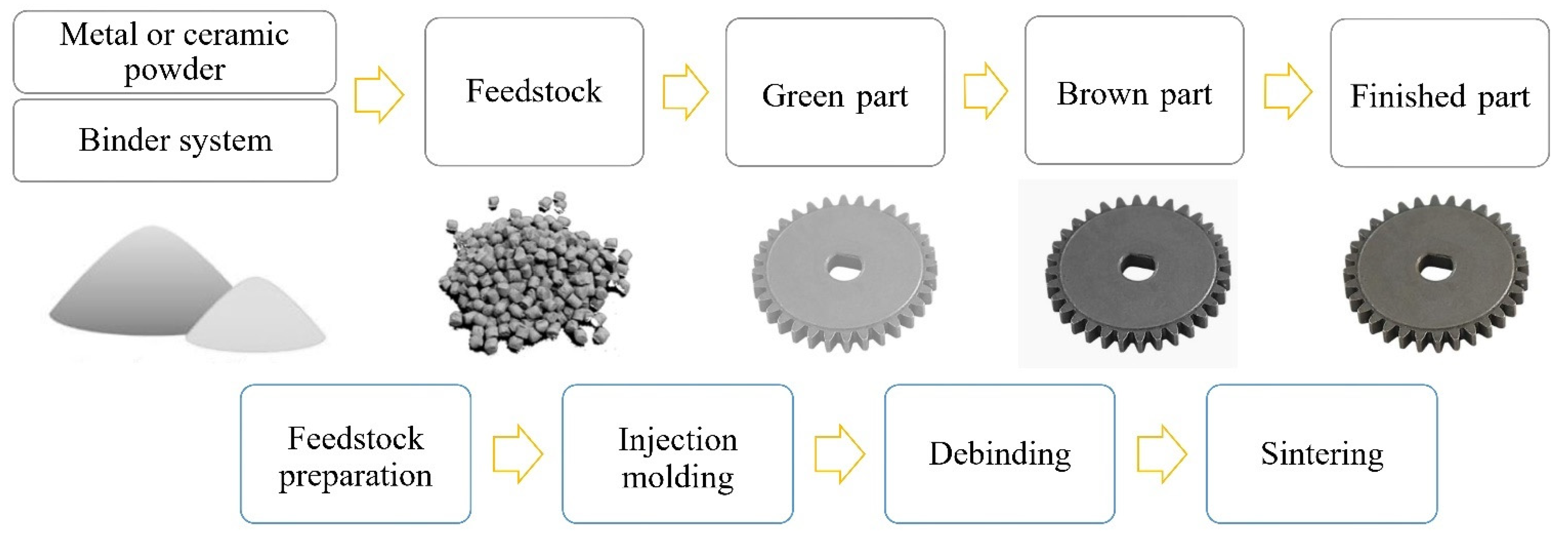
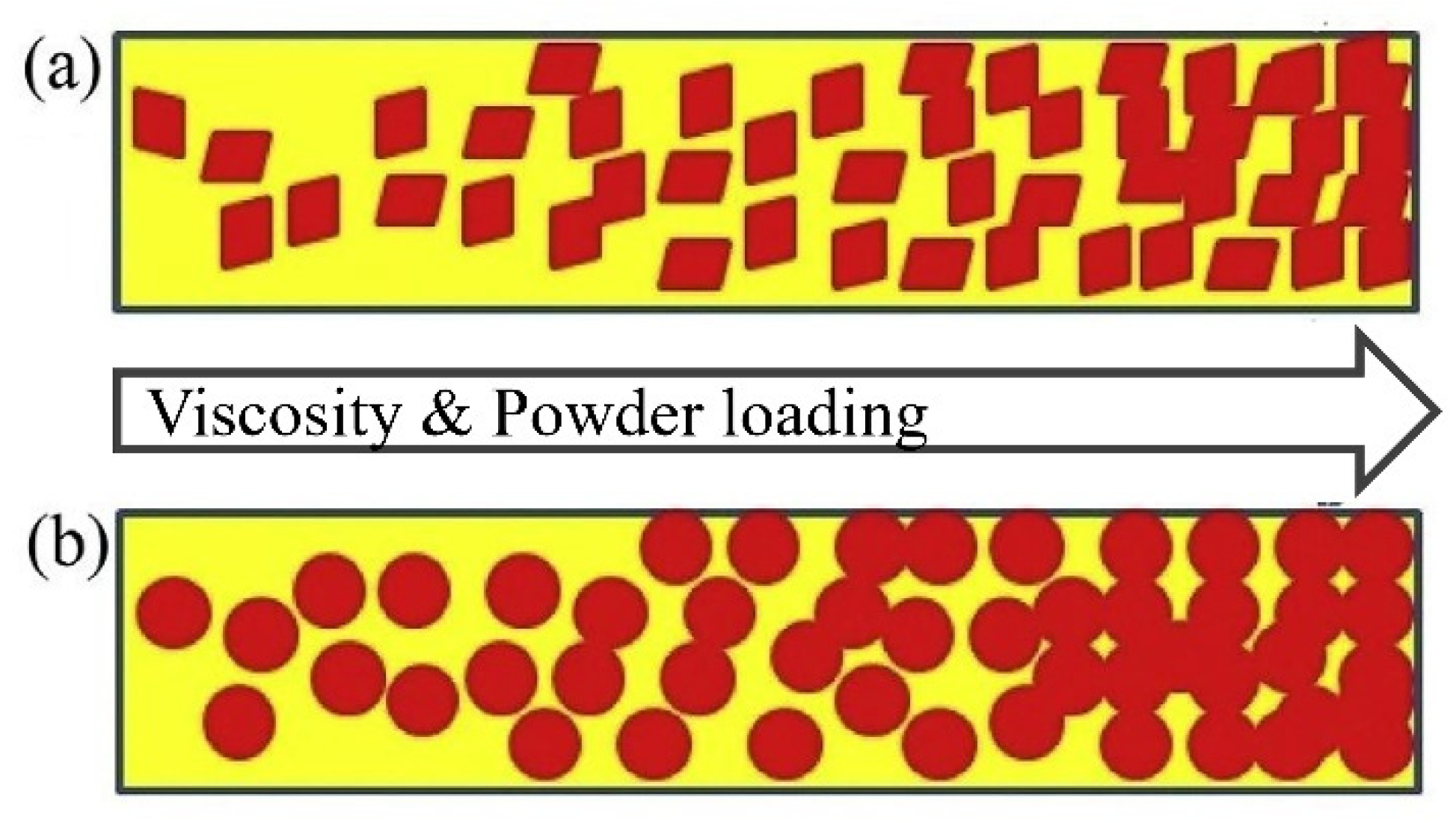

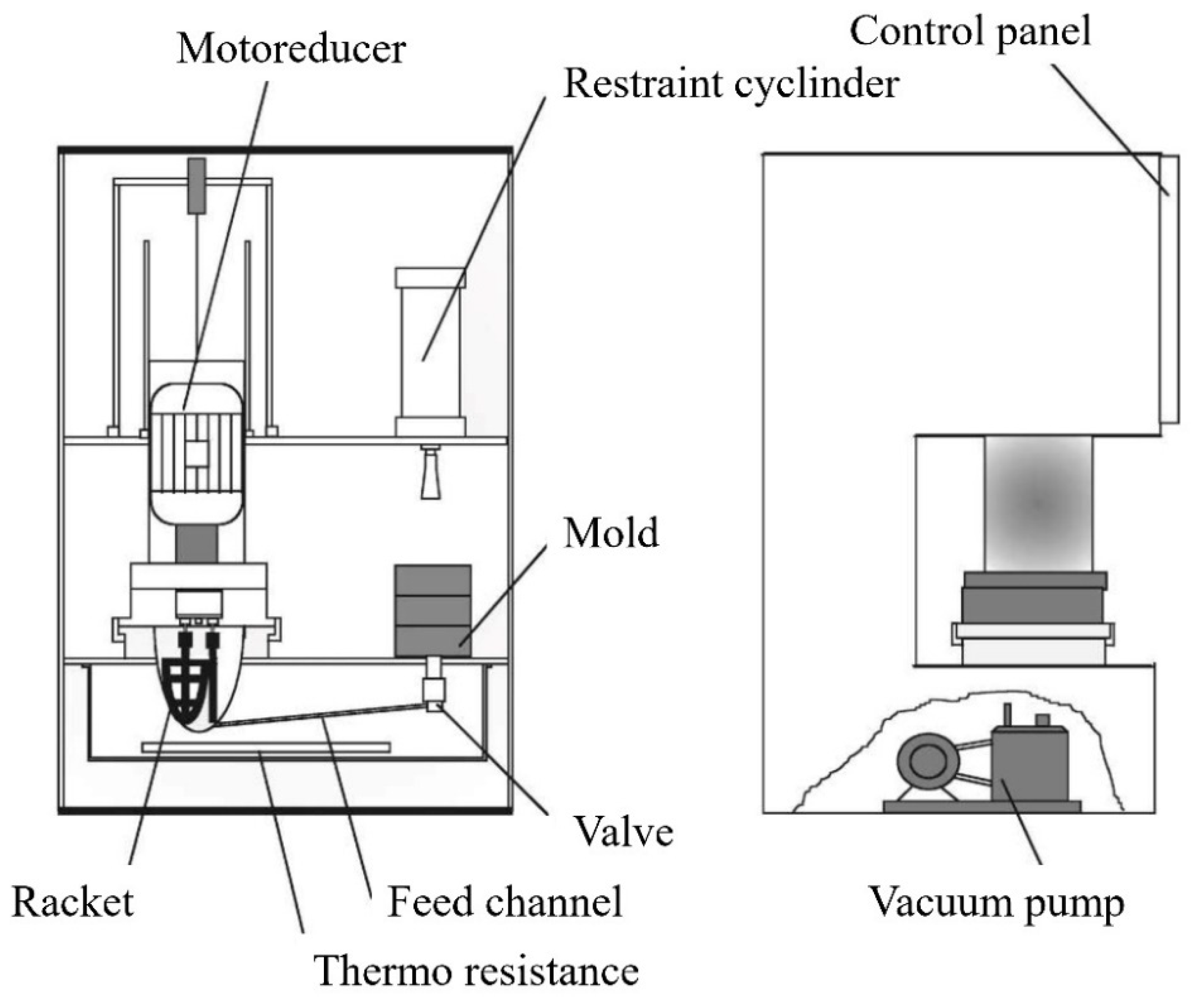
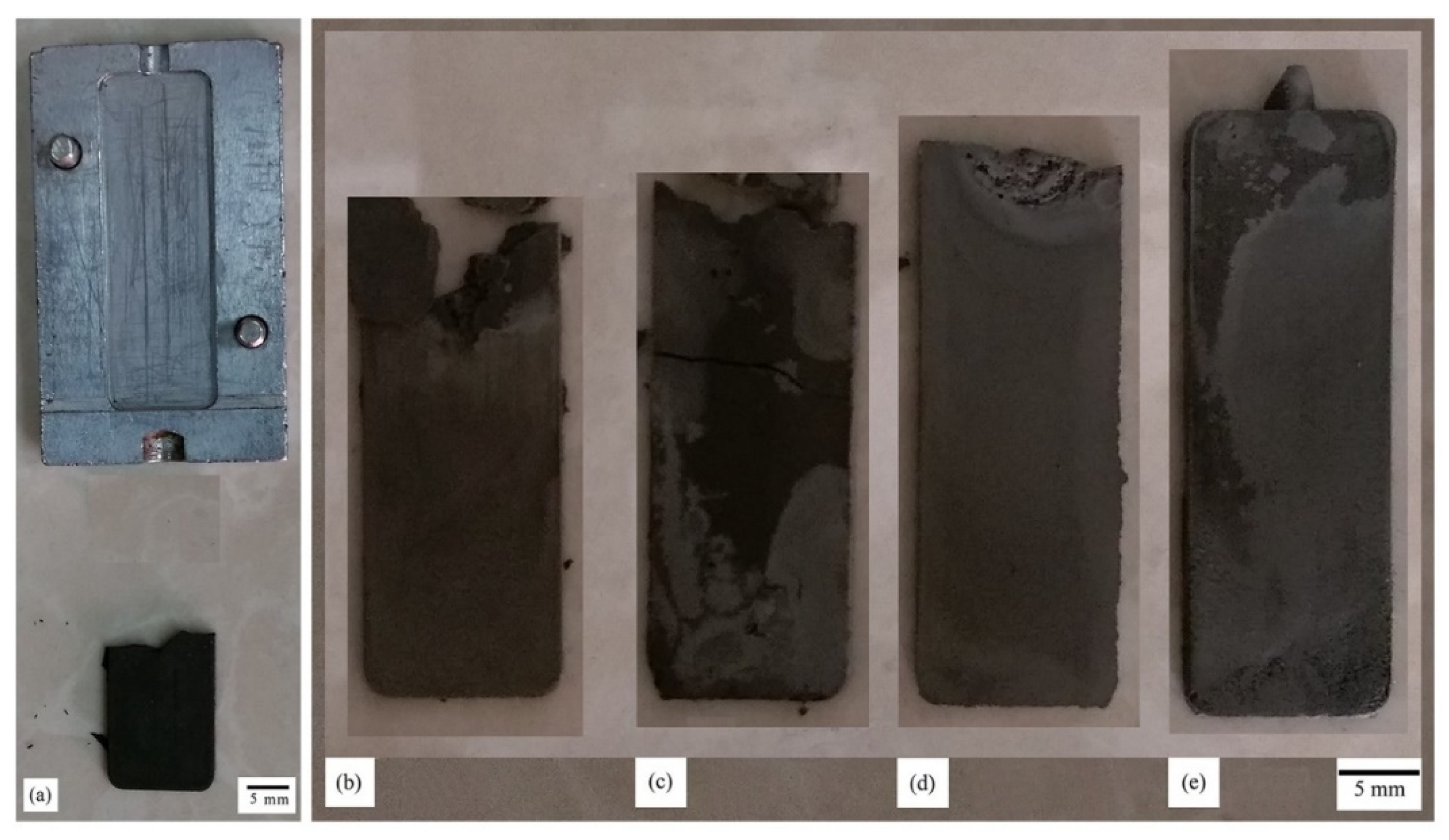
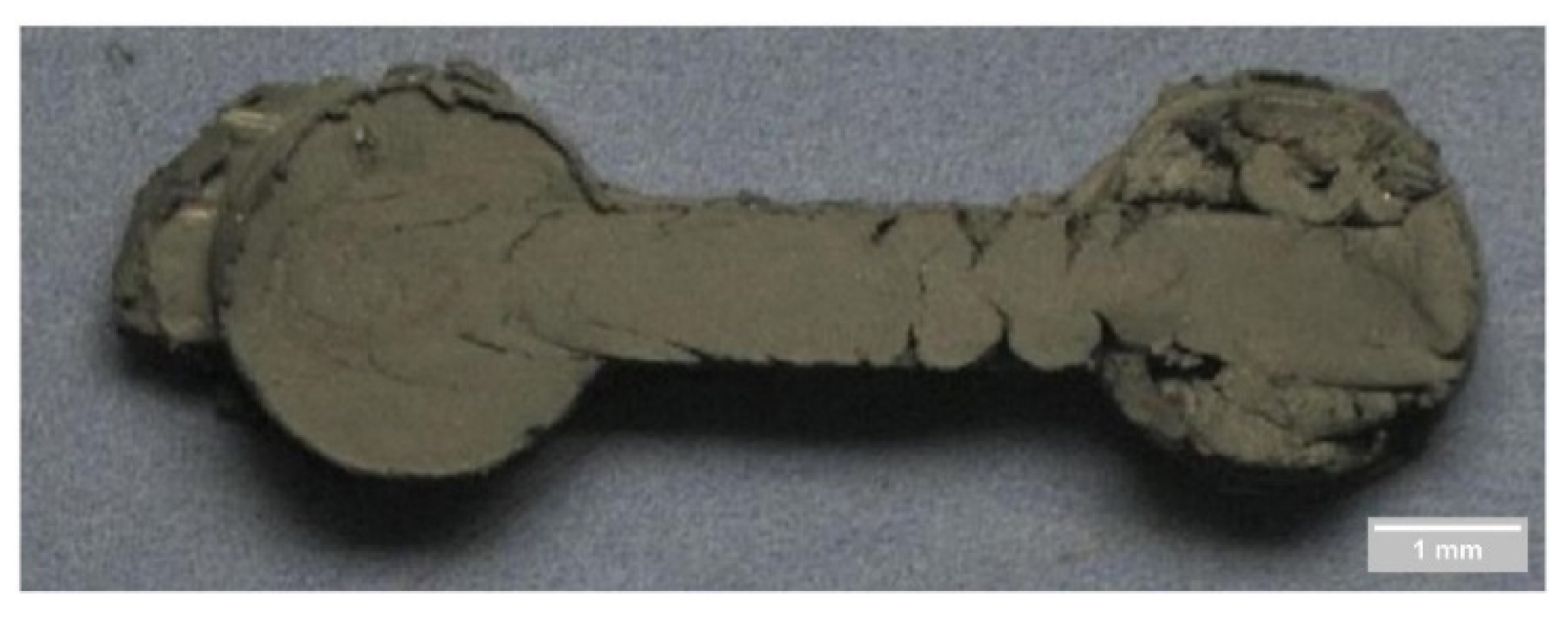

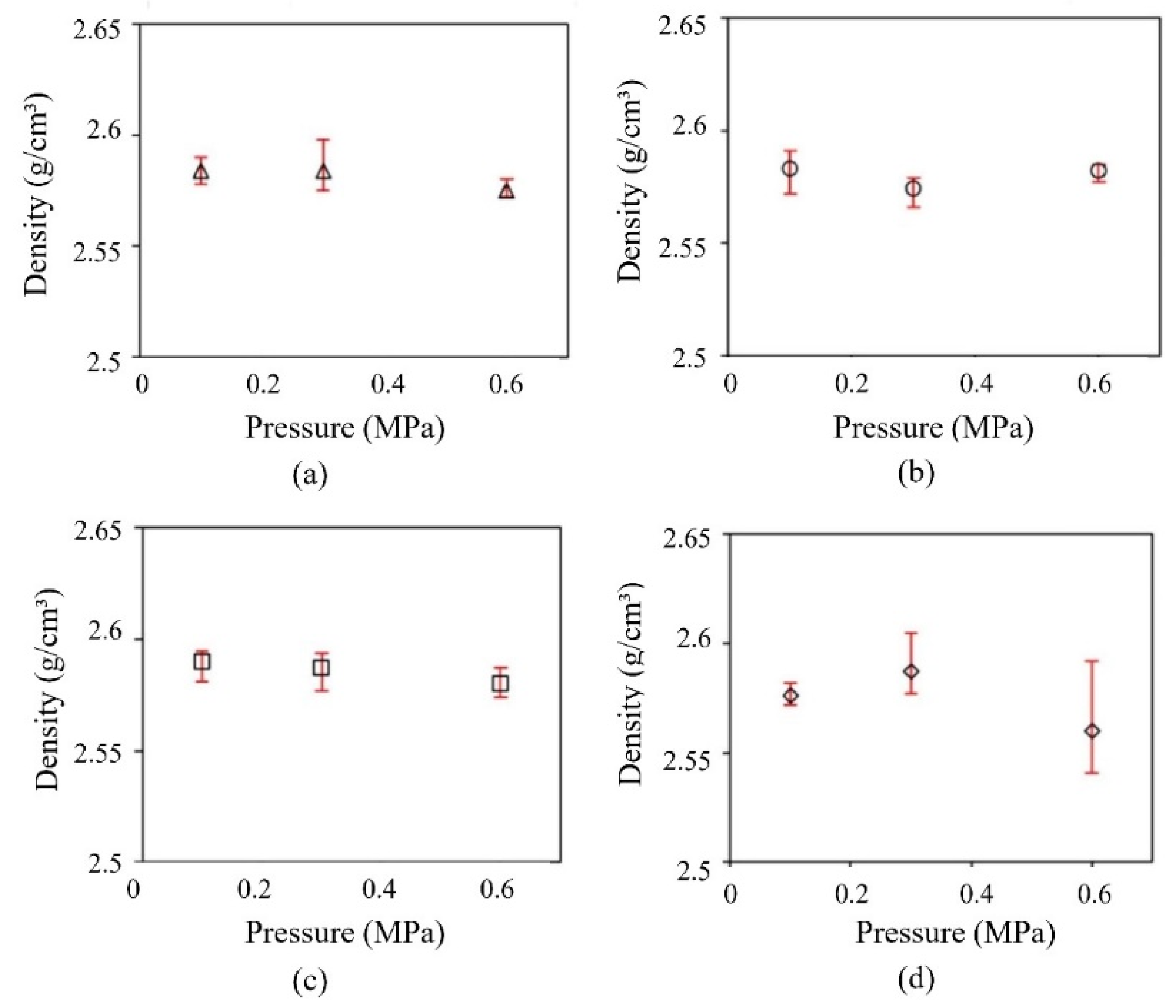

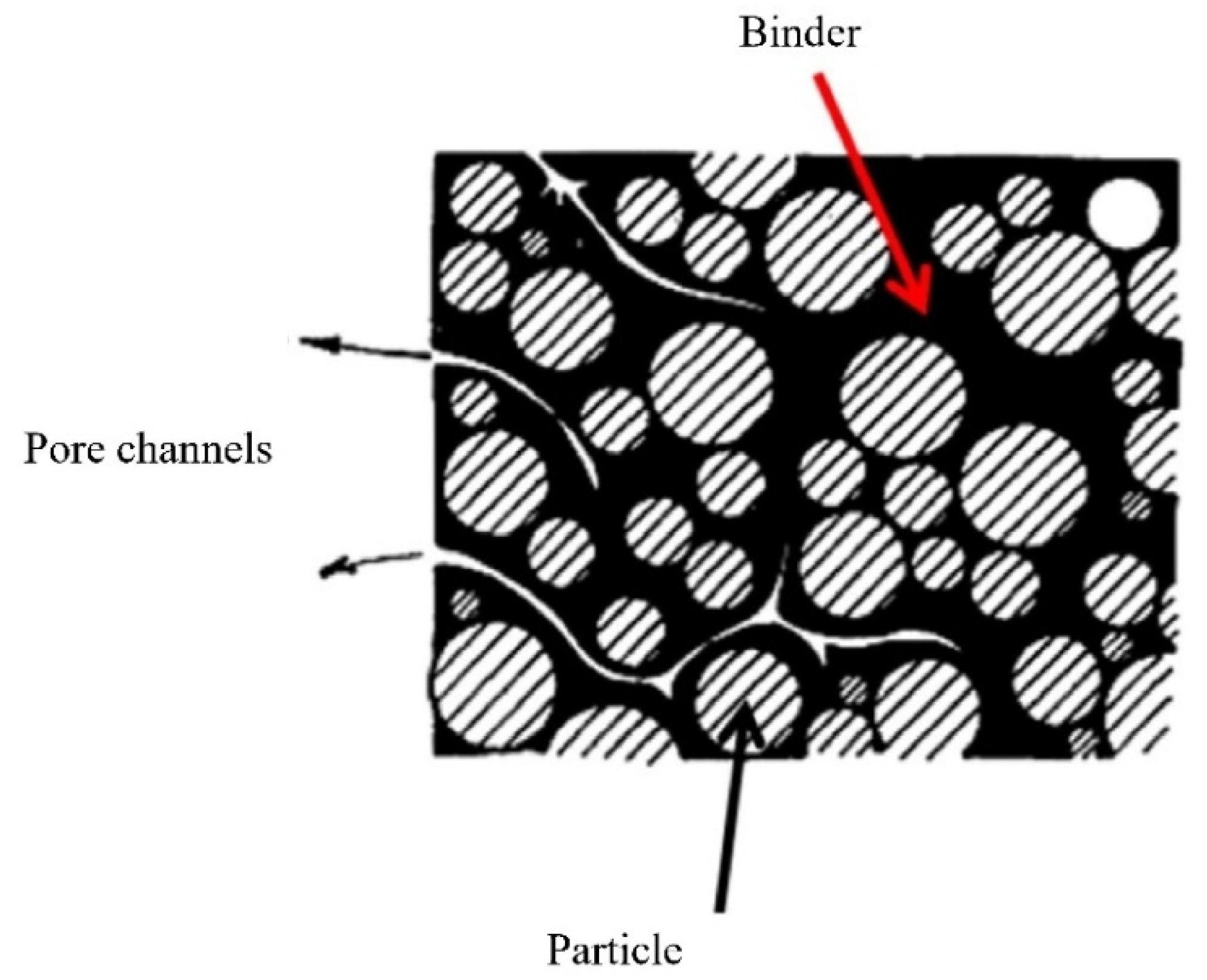
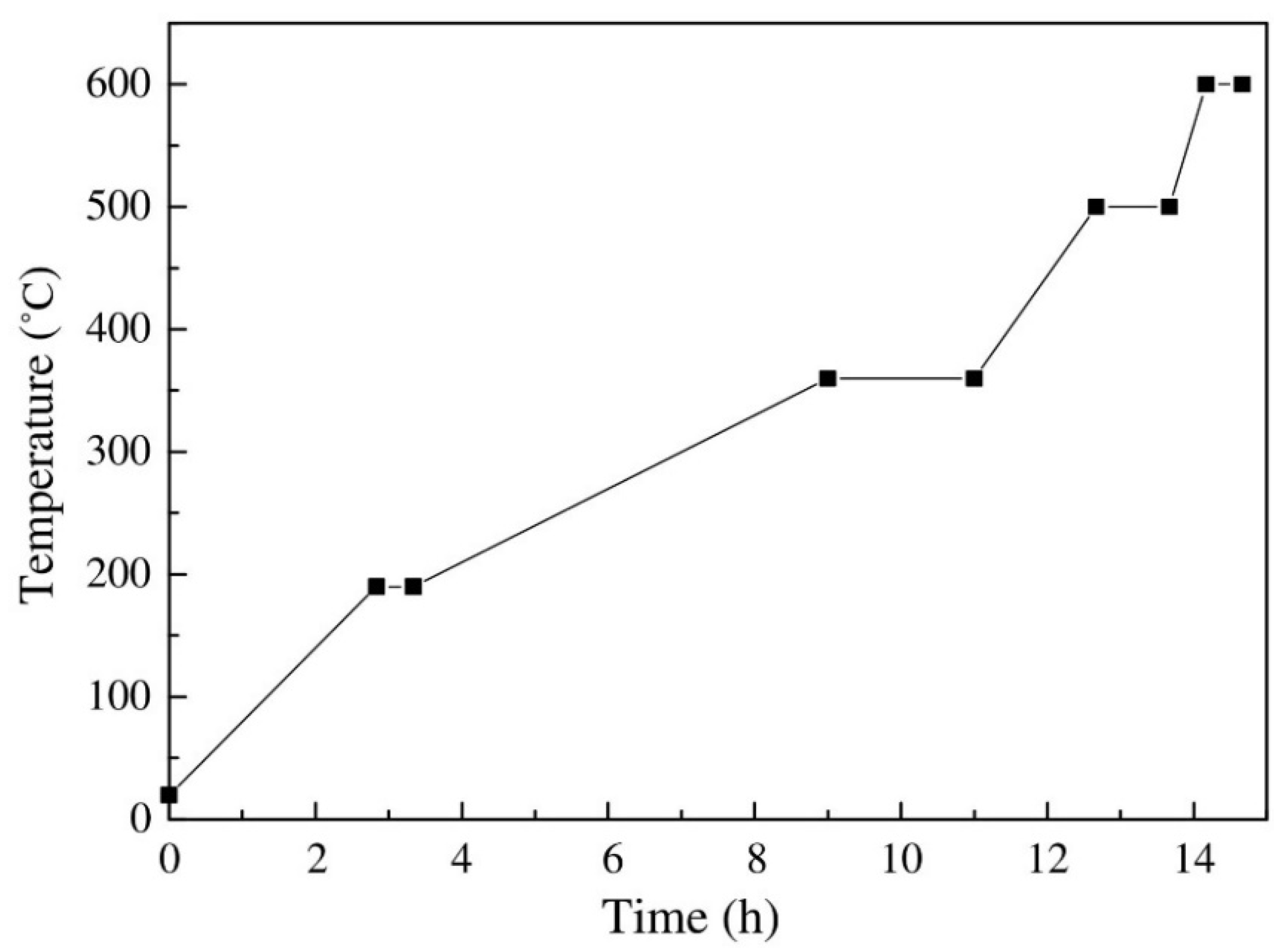
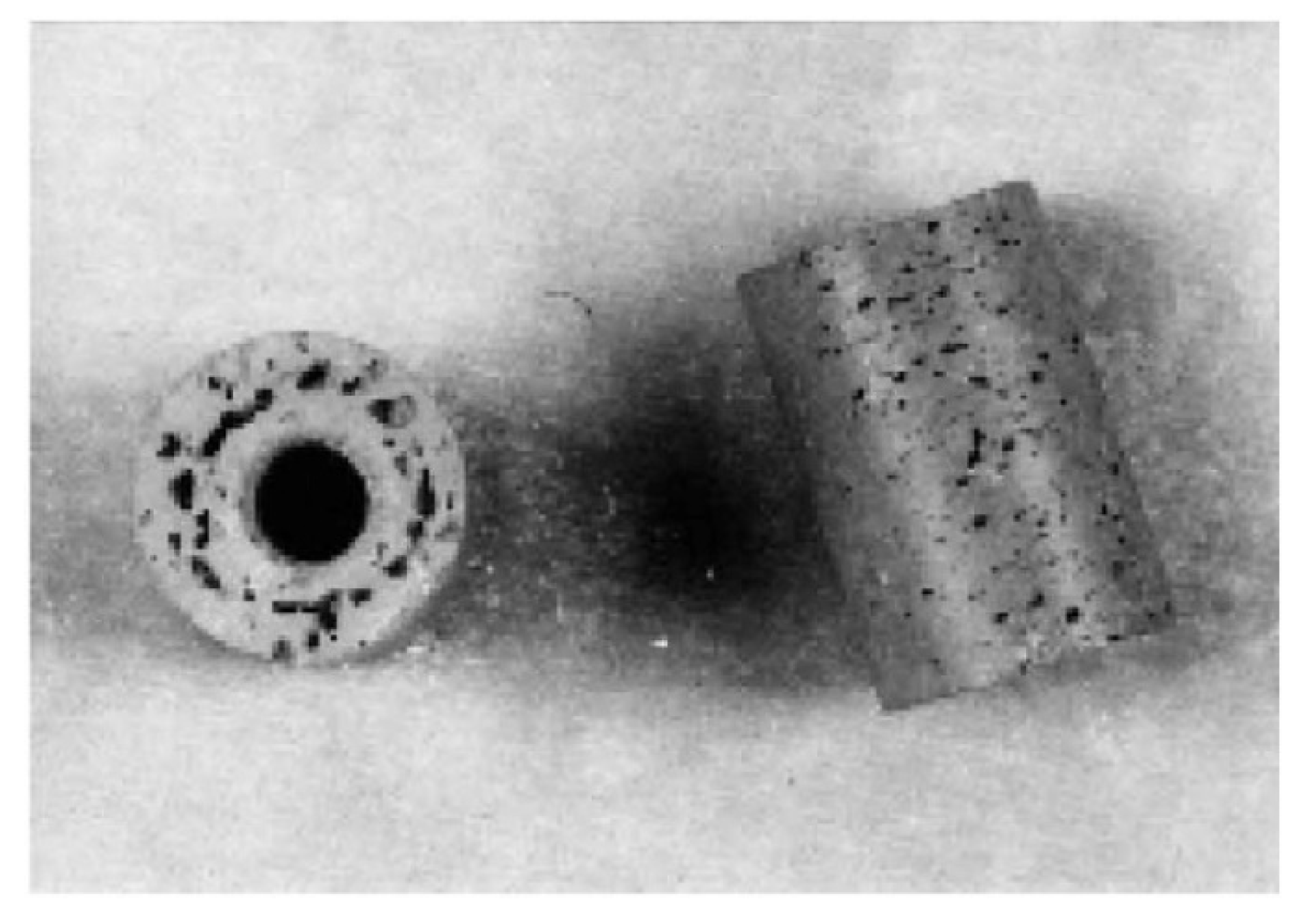
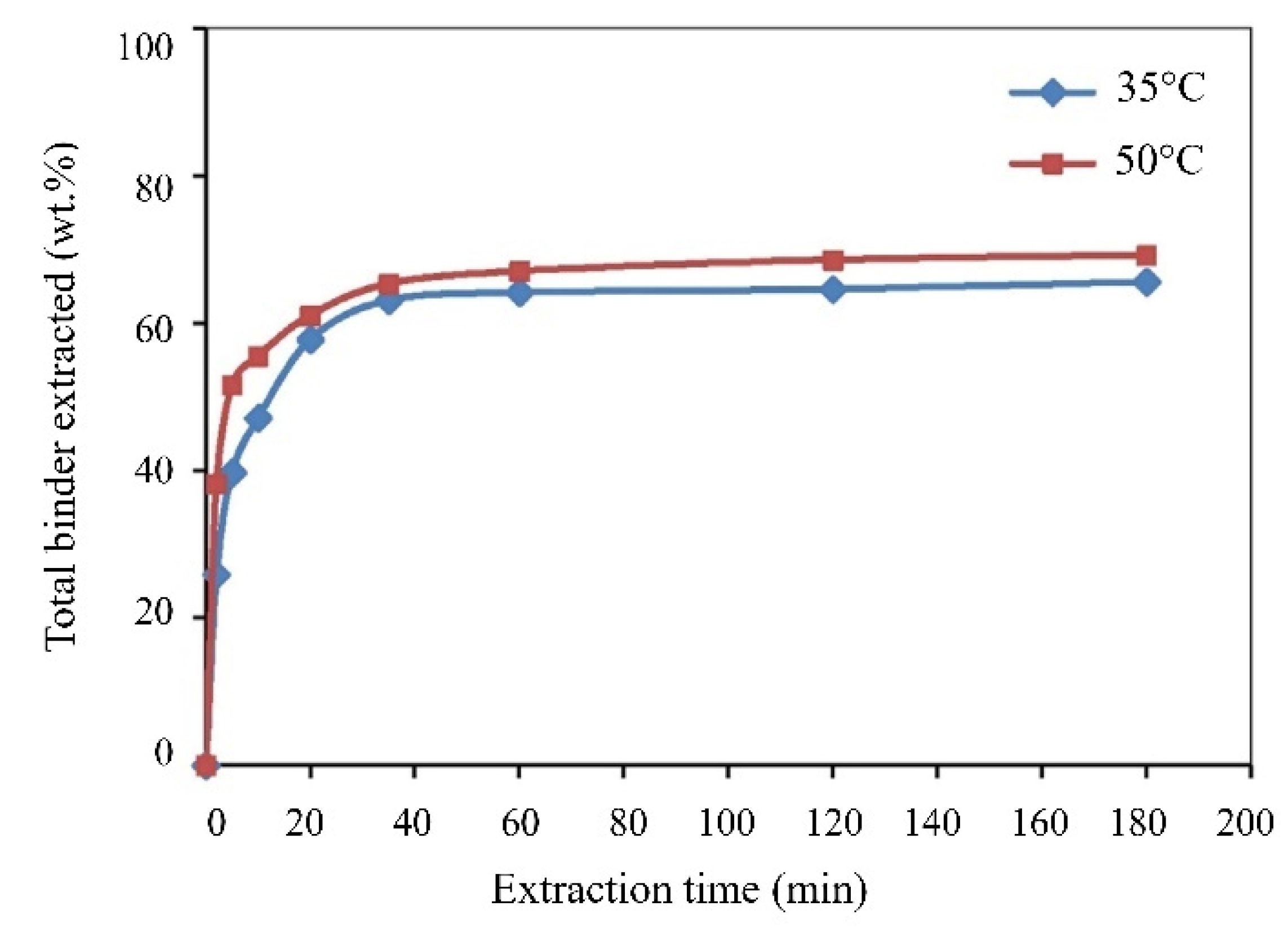
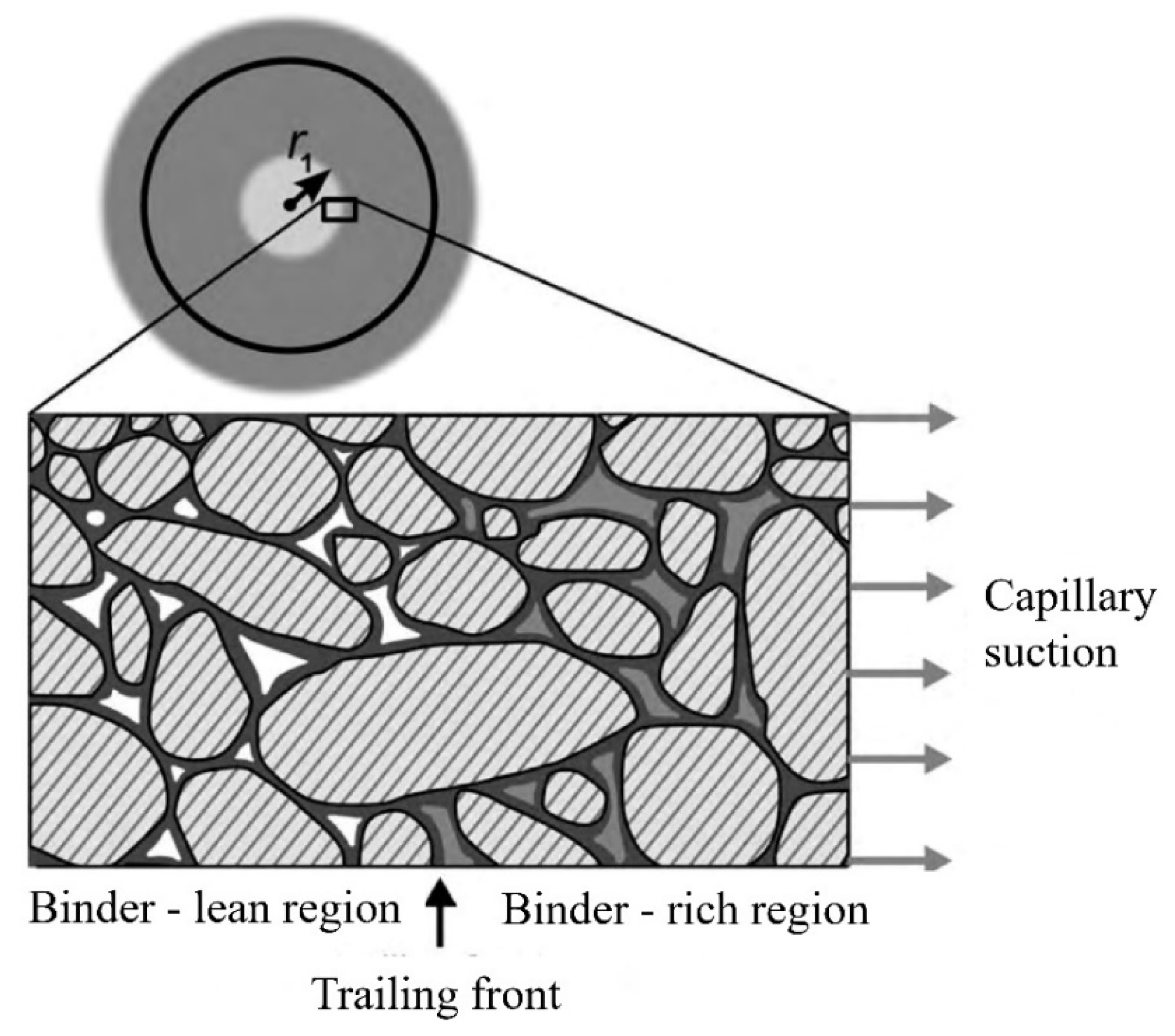
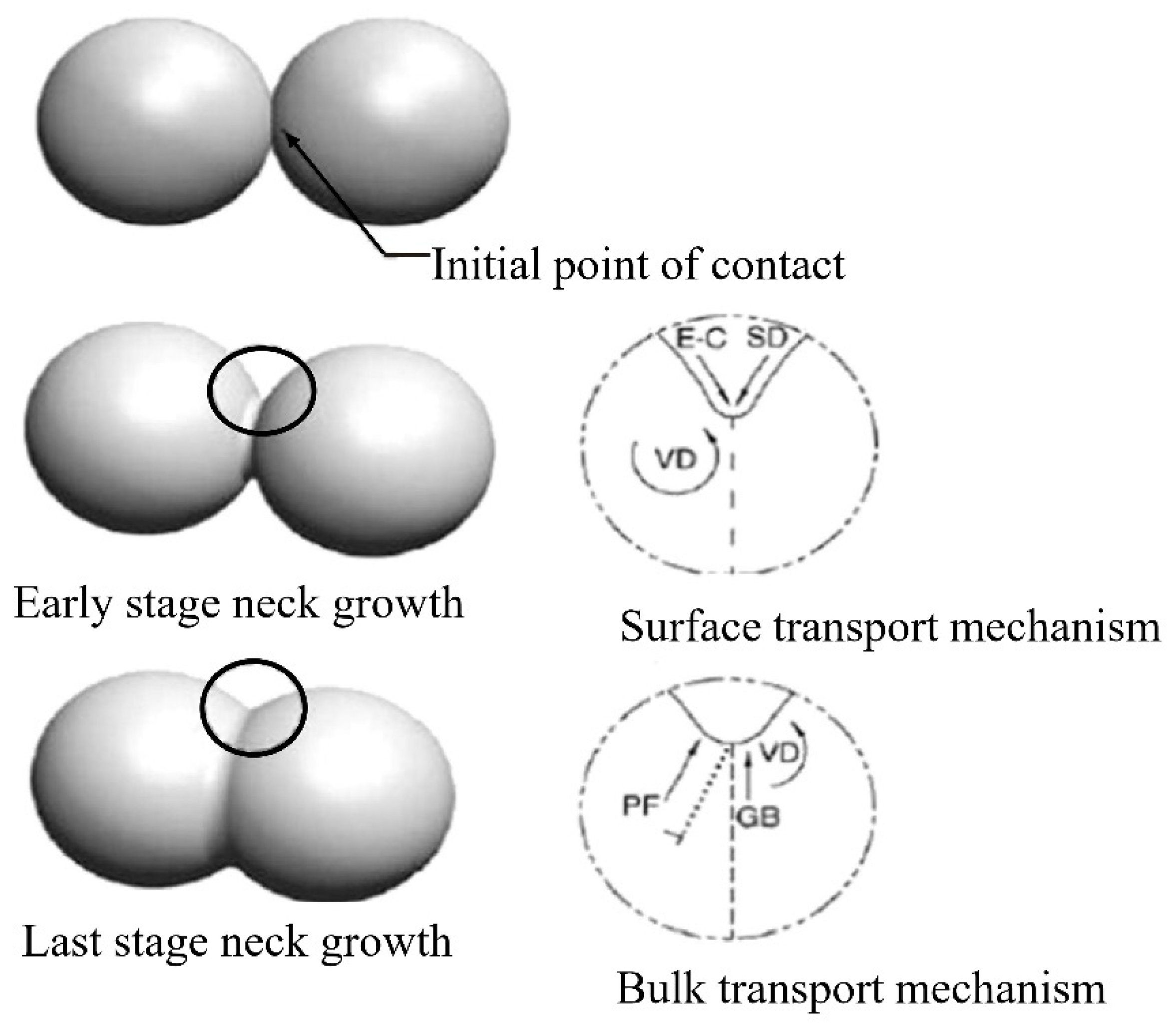
Disclaimer/Publisher’s Note: The statements, opinions and data contained in all publications are solely those of the individual author(s) and contributor(s) and not of MDPI and/or the editor(s). MDPI and/or the editor(s) disclaim responsibility for any injury to people or property resulting from any ideas, methods, instructions or products referred to in the content. |
© 2022 by the authors. Licensee MDPI, Basel, Switzerland. This article is an open access article distributed under the terms and conditions of the Creative Commons Attribution (CC BY) license (https://creativecommons.org/licenses/by/4.0/).
Share and Cite
Momeni, V.; Hufnagl, M.; Shahroodi, Z.; Gonzalez-Gutierrez, J.; Schuschnigg, S.; Kukla, C.; Holzer, C. Research Progress on Low-Pressure Powder Injection Molding. Materials 2023, 16, 379. https://doi.org/10.3390/ma16010379
Momeni V, Hufnagl M, Shahroodi Z, Gonzalez-Gutierrez J, Schuschnigg S, Kukla C, Holzer C. Research Progress on Low-Pressure Powder Injection Molding. Materials. 2023; 16(1):379. https://doi.org/10.3390/ma16010379
Chicago/Turabian StyleMomeni, Vahid, Margarete Hufnagl, Zahra Shahroodi, Joamin Gonzalez-Gutierrez, Stephan Schuschnigg, Christian Kukla, and Clemens Holzer. 2023. "Research Progress on Low-Pressure Powder Injection Molding" Materials 16, no. 1: 379. https://doi.org/10.3390/ma16010379
APA StyleMomeni, V., Hufnagl, M., Shahroodi, Z., Gonzalez-Gutierrez, J., Schuschnigg, S., Kukla, C., & Holzer, C. (2023). Research Progress on Low-Pressure Powder Injection Molding. Materials, 16(1), 379. https://doi.org/10.3390/ma16010379










